
a collection of notes on areas of personal interest
- Introduction
- Arabic / Islamic design
- Arabic / Islamic geometry 01
- Arabic / Islamic geometry 02
- Arabic / Islamic geometry 03
- Arabic / Islamic geometry 04
- Islamic architecture
- Islamic urban design 01
- Islamic urban design 02
- Islamic urban design 03
- Islamic urban design 04
- Islamic urban design 05
- Arabic / Islamic gardens
- Gulf architecture 01
- Gulf architecture 02
- Gulf architecture 03
- Gulf architecture 04
- Gulf architecture 05
- Gulf architecture 06
- Gulf architecture 07
- Gulf architecture 08
- Infrastructure development
- The building industry
- Environmental control
- Perception
- The household on its lot
- A new approach – conceptual
- A new approach – principles
- A new approach – details
- Al Salata al jadida
- Public housing
- Expatriate housing study
- Apartment housing
- Pressures for change
- The State’s administration
- Society 01
- Society 02
- Society 03
- Society 04
- Society 05
- Society 06
- History of the peninsula
- Geography
- Planning 01
- Planning 02
- Population
- Traditional boats
- Boat types
- Old Qatar 01
- Old Qatar 02
- Security
- Protection
- Design brief
- Design elements
- Building regulations
- Glossary
- Glossary addendum
- References
- References addendum
- Links to other sites
Work
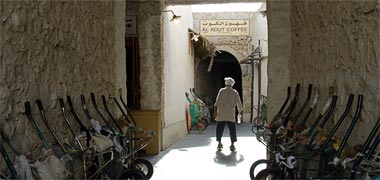
It is instructive to look at the Government figures relating to the workforce in Qatar in order to obtain something of an understanding of the predominance of expatriate workers there are in the country. But a distinction has to be made about the economic realities requiring the importation of significant numbers of workers in the construction and service sectors of the economy, and attitudes to working within the national community where there are significant cultural differences due to a number of historical factors.
In terms of a job, work is an ambition of most Qataris, though this conflicts with traditional attitudes of the badu. An aversion to work has been commented on by authorities in Oman, Bahrein and Kuwait and is considered to be a serious obstacle to the integration of nationals into a modern State. There are two reasons normally given by those who wish to work. Firstly, and in this order,
- they believe they are assisting the State in its development and repaying the Ruler for his help in improving their lot and,
- secondly, they must obtain the means to provide for their family.
Usually, this meant obtaining a job with the Government as there was little commercial activity in Qatar, and insufficient opportunity for an ordinary Qatari – unless he or his family were independently wealthy – to obtain the necessary funding with which to obtain on the open market a plot of land upon which to build a house. Although there is significant commercial activity now, there is still a problem buying land as it has dramatically increased in price.
In the West it is a commonplace attitude that the Arabs of the Gulf are rich. Both Westerners and northern Arabs believe this and it has been at the heart of much of the dislike felt by both groups towards Gulf Arabs. The reasons are essentially historical but many commentators have noted the continuing trends and mechanisms that perpetuate this unhelpful attitude. The invasion of Kuwait by Iraq was argued to be partly a consequence of the refusal of Kuwait to support its Arab shaqiqa to the extent to which the latter would like to be come accustomed.
Gulf Arabs have always been aware of the jealousies within these areas, and the extent to which they are disliked because of their wealth. In a political sense, budgets are found to assist poorer Muslim and other States but, in a personal sense there is a keen but hidden antipathy towards the more aggressive Arab States and the dangers they represent. In their awareness of this, some members of the Kuwaiti ruling family stated that they would institute a more egalitarian or democratic State when they returned to their country. This they are moving towards, as is Qatar following a series of novel initiatives made by the Ruler, Sheikh Hamad bin Khalifa and his wife, Sheikha Mosa.
This issue is also associated with the arguments for a more visible female profile in the society, and it is possible that these attitudes are now moving out from Qatar to encompass and encourage other nationals of the Gulf States. In this it might be thought that political and ameliorative policies are amalgamating at the expense of those Islamic ideologies discussed elsewhere. It is difficult to guess how progress will be made, and its extent. Women did not win any seats in the Kuwaiti elections of mid-2006, though the elections did see reformists making strong gains.
In the nineteen eighties and nineties there were, in Qatar, a number of financial problems associated with the inherent stability of the United States Dollar and its value in relation to other currencies, and the price of oil. The effect of this was that Government attempted to restrict the spending of funds. In turn, this created a situation in where there was little productive work. This applied to both the public and private sectors, particularly the latter which is heavily dependent upon Government for its funding.
Because of the lack of productive work there was a tendency for staff to have a casual attitude to the responsibilities for which they were paid, and this was reinforced by the lack of training towards work as a function of society. It was not thought to be necessary to work full time in order to carry out one’s job.
An important and complicating factor has been the understandable policy of expatriates to try to ensure they remain in work, and that their compatriots also do. To this end it is possible to identify a number of policies enacted by expatriates to relieve Qataris of the burden of their work. All is carried out in the spirit of genuine assistance and may – and often does – result in the expatriate working harder; but the result is the same: the Qatari will have less to do, the work will be carried out and everybody is relatively happy.
Times have now changed as there is certainly considerable work around. Many Qataris have left public service in order to take their position in family firms or to start business themselves. Some still work in the public sector but operate businesses through managers. This requires them to operate both public service and private work coevally, a balancing act which, when observed, seems to work quite naturally, but tends to frustrate expatriate businessmen who are unable to understand and work within the system.
Some nationals, as a matter of course, will often tell you how hard they are working, but this more usually supports the argument that they are not, and that they are aware of it. Having said that, it is possible to observe them working hard but not in a manner familiar to Western professionals. Those nationals who have studied abroad are particularly aware of this, but it is possible that the system in education where students have everything provided for them – which would not be the case in the West – also is harming younger Qataris. There appears to be a serious problem with young men not being able to develop responsibilities in the professionally related activities that can be argued to begin at the level of their tertiary education.
Arguments have been made to encourage young Qataris to obtain not just university degrees but professional associations in the West. To some extent this has worked in the medical profession, but not really elsewhere. It was suggested, for instance, that all nationals obtaining a professional degree should then work in a related office or offices abroad with a view to both learning the practicalities of office work as well as obtaining a foreign professional qualification. It was seen that there would have been a bonus in forging relationships with those professional offices.
The reason for this not working is that nationals can’t really afford to spend time out of their country, away from their families and the fast pace of development within Qatar. To a large extent this reflects the way the majlis works, the mainly informal system by which intelligence is passed within the community. The work model, then, is very different from that obtaining generally in the West, though it not perceived as such either by nationals or expatriates.
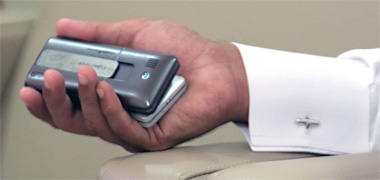
Westerners are generally unable to perceive evidence of a work ethic with which they are familiar; where productive effort is seen to be good in its own right or necessary for self development – the traditional Christian work ethic. They are not used to loose time keeping, meetings being dropped, people bursting in on meetings, more than one meeting being held at the same time, being introduced to strangers and having no idea of their status and relationships, promises being made and apparently being reneged on and, nowadays, the continual use of one, two or three mobiles interrupting the flow of conversation and business. There are many other complaints I have heard, but this latter is interesting as it reflects so well the manner in which the earlier mentioned majlis system operates.

In the early days of the State’s development telephones were an important element in facilitating the exchange of information so necessary to running private and public affairs. Meetings were interrupted by calls coming in and being made and most nationals had a large number of telephones ranged across their desks that were constantly in use. There was quite an important hierarchy for this arrangement which I have mentioned elsewhere. But now the mobile has taken over from telephones, not just as it has in the West, but to a far greater extent. The accompanying photograph, taken from a local newspaper in August 2008, notes penetration of the mobile market of 150%.
The foregoing may seem to be a detail but the note is there to illustrate one of the mechanisms illustrating how both work and personal affairs have developed. Mobiles may appear to disrupt meetings more than was the case with fixed telephones or the apparent lack of privacy, but it is just a development of the traditional manner in which society operates. Its significance is that it is now possible to speak to people all the time, wherever you are, and this opportunity is taken to an extent more than in the West.
Whatever the mechanisms for work, and the degree to which it is effective in Western terms, there is a very strong attitude among nationals who feel that they should repay the State and attempt to assist its development. There is a level of loyalty to the State that has disappeared from many other countries and that most Westerners may find unusual if not a little uncomfortable when they first experience it in Qatar. This is similar to the loyalty that is felt towards family and qabila and, in that sense, is an extension of that loyalty.
Because of this feeling, many nationals genuinely wish to benefit the State and are happy to work for the public service, but the mechanism they use to progress their service is to combine it with private business as there, too, they have a loyalty impelling them to support their family in both the specific and wider sense.
But management is still learning its skills within the State and many who work either do not have the goals properly defined for them, are unable to define goals themselves, or are rendered ineffective by the lack of integrated back-up. Management studies have been organised at the top of middle management level for Qataris only, but it appears to be having little practical effect. One of the reasons for this could be due to the fact that managers still require loyalty to themselves above loyalty to the organisation, and this is often the manner in which staff are selected and placed in their jobs within Government as well as within private commercial organisations. Loyalty to an individual conflicts with the need for an organisation to operate as a professional system, and this stems from the traditional way in which business has been carried out in the region.
It can also be argued that government, in facilitating placement of Qataris in the workplace by their additional support – such as the provision of drivers to take them to work, pay and holiday differentials, relaxation of supervision, and so on – establish a hierarchical system at odds with the requirements of efficient and effective commercial and administrative organisations.
The lower levels of management are almost exclusively the preserve of non-Qataris who maintain the records and correspondence and carry out all the necessary traditional support tasks. Although some new systems are being introduced, there are three essential difficulties:
- generally the skills being used are those learned under systems developed from, or directed by, colonial administrations and which, in many cases, continue unchanged,
- where new systems are introduced there is minimal skills development with existing staff, and
- as has been mentioned above, many of the expatriates have a direct interest in ensuring their continuing role within the country regardless of the efficiency of their own operations.
Taking this natural resistance into account, new management skills and techniques are proving difficult to introduce into Government departments. There is little in the way of change management operating to alleviate this resistance to the development of efficient organisations, and new systems, while appearing to improve management, are neither developing well nor integrating with those of other organisations. In fact, this is also applicable to the organisations themselves.
A complicating factor is that very few graduates seem to want to work within their field of expertise but seek other areas which, when they are rebuffed, tend to make them unhappy in their directed field. For the better students who are able to gain academic places abroad this is perhaps due to their being required by the Ministry of Education to stay within the initially selected field of study despite an increasing awareness of the wider fields available to students in the West. For the students who graduate from Qatar University it is perhaps due to the limited variety of disciplines available to them and the lower standard of the course compared with, particularly, the American courses from which the majority of Qataris permitted to study abroad graduated.
As the University is relatively new, being founded in the early nineteen eighties, it is perhaps not surprising that there is a disbalance between the output of the secondary schools and the requirements of government where the majority of Qataris will be found a place.
It seems to be evident that the work force is generally not crafted to suit the tasks it has to perform, and that the tasks themselves are ill-defined and unbalanced with poorly expressed and imprecise objectives and goals.
This problem is not restricted to Qatar but has been commented on in other Gulf States as well as in Saudi Arabia. In the latter country, blame has been attached to a combination of the failings of the educational system and an over-dependence on a foreign workforce. Although there is change, it is slow and it comes at the expense of growing impatience in the young.
Achievement is not measured in terms of accomplished objectives or goals. It is ambiguous and appears to be related to lack of perspective within all organisations as well as to the failure of the educational process to deal with the concepts of work, job satisfaction and progress. It is sad to note the numbers of Qataris who do not understand, or carry out satisfactorily, their jobs and who are unhappy at work. Achievement is more accurately related to the individual’s placement in society, and this depends in many respects on the operation of the socio-political workings embodied in the qabila system.
Women in the workplace
Increasingly, change is being introduced to the workforce market. Qatari women are now working in the private sector as well as for government, and not just in offices where they might not be seen, but in front line positions. Traditionally women were to be found in the Ministries of Labour and Social Affairs, Education, the Interior and Health, but they are now to be seen more openly, working in areas such as Immigration and other departments where there is a need to meet the public. For instance, government departments now have booths within shopping malls where female employees are available to meet householders who are unable to visit government departments during normal hours. While making a small beginning to resolve the problem of the disbalance between nationals and expatriates, the increasing exposure of women has introduced or exacerbated a number of other problems.
The issues relating to the education of women are some of the most significant in the Muslim world. These are religious and socio-political in nature, and their potential as agents for change is recognised as such both by those not wishing to see women move out of their traditional roles as well as those who want to see change. Much of the reason for this seems to originate from Islamic initiatives within the Western world where a degree of emancipation is thought to be a prerogative for developing a modern society. But there has also been a tradition in, generally, northern Arab states for women to take a similar role to men. But there has been, and continues to be, resistance.
In addition to religious rationale, colonialism is thought to be one of the reasons that women were not educated as were men due to the colonising powers having no interest in moving women out of illiteracy, this replicating, but to a greater extent, attitudes in their own countries. The nineteenth century witnessed education of women in some of the northern Arab states, but not in the Gulf until the latter part of the twentieth century.
While many see the increasing visibility of women in public as reflecting changing moraes, there are those who believe that there is less progress to gender inequality in this part of the Arab world than is being made elsewhere. Religion and education may be forces for change but some suggest that it is oil and its development behind an inequality of gender balance and the increasing stresses this creates within society. This argument suggests that women being unable to access the labour market results in higher fertility rates, poorer education and a diminished influence within the family. This, in turn, leads to a lessened ability to exchange information, develop political focus and gain representation in government; all these being areas where political and social emancipation is developed – outside the home. However, this appears not to be the case in Qatar where the initiatives resulting from the improved access to education for women appears to be having the opposite effect.
A look at the programmes of the University, the guest lecturers, the conferences, the exhibitions and the stated goals is interesting. It is in education and the importation of teaching staff and their programmes, particularly in tertiary education, that the initiatives relating to changing society can best be identified. These appear to mirror programmes in the Western world while making little allowance for cultural change.
The education of women to tertiary standards is a policy that is being directed from the highest levels. H.H. Sheikha Moza, has stated the goal to be:
…educating the whole nation. It’s upgrading…the education system, social system and political system. It is bringing a different environment, a different culture, to this nation.
It is not difficult to appreciate how ambitious this is, and how it might seem to other Gulf states. In fact she goes on to say that
Geographical lines and borders, they have no power at all. Not any more at least. They just reflect the sovereignty of the states. But I don’t think that there is sovereignty over people’s minds. What’s happening here in Qatar could affect the rest of the region. This is a possibility we shouldn’t deny.
Referring to Qatari women she goes on to state:
I hope that these changes will affect them in very positive way. [They] have potential. In the proper environment, they can reach their full potential. And this is what we are trying to do here. We are trying to create the right environment, because we don’t believe [Qatari women] are any less than anyone else in the world.
In many ways Qatar is in the vanguard of the Gulf, an issue which is receiving mixed comments as it promises to disturb many of the socio-political moraes of the region. The university system has expanded dramatically and caters for a large proportion of the women in the country. This has created a socio-cultural phenomenon which did not exist a generation ago; the university has become a social entity, a form of separate ecosystem. I shall make notes about this elsewhere but its relevance here is in establishing expectations.
Curiously to casual observers, the proportion of women entering tertiary education is greater than men in Qatar – 57%, in fact, and this proportion is similar in Bahrein and Kuwait. The reason appears to be twofold. Firstly, it is easier for men to move abroad to study, both practically and with the provision of a government grant. Secondly, and conversely, there are practical socio-cultural difficulties for women moving abroad to study as well as family pressures attempting to have them remain in Qatar and marry.
The point of this, and with relevance to the workforce, the university system is producing a cadre of well-educated, confident young women who are competent, believe in themselves and, in many cases, wish to take their place in the workplace. The difficulty is that there are not the opportunities that many of them would like due to a combination of the traditional practice of separation of the sexes, and the matching of education to employment opportunities. In addition there continues to be resistance within some families to women working or, perhaps more accurately, for them working in certain areas or positions. Just as important are the conflicts arising in the hierarchical placement with regard to men.
In addition, the focus on tertiary education – for both men and women – has meant that vocational and technical education initiatives have not progressed. This exacerbates the problems of opportunities for women in the workplace.
Traditionally, women have seen their most likely employment in areas within the field of medicine, particularly gynaecology, pharmacology and dentistry, along with education where there is an obvious need for female teachers, the law and the arts though acting has been traditionally frowned upon. The media generally are likely to attract women to them, and the fact that Qatar is the home of Al Jazeera, makes this field more attractive to them. Areas such as science and engineering are still very much the preserve of men as they are in the West.
Increasing emancipation sees more women in public wearing, for the most part, the hijab. The various uniforms worn by women in the workplace use a form of this for head covering, usually matched in colour with the rest of the dress.
The increased incidence of women in the workplace has meant the employing of additional transport. Qatari women tend to be taken to and from work by a chauffeur, very few of them using the small buses operated by some organisations. This has brought about additional traffic loading of the road system, contributing to the problems that are experienced every day by nationals and expatriates alike. However, with the advent of mobile ’phones, the irritation of long journeys can, to some extent, be ameliorated.
more to be written…
Expatriates
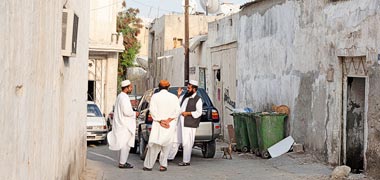
The majority of the population are expatriates who have come to work in Qatar in increasing numbers since the nineteen thirties. The majority of them appear to be non-Arab speaking foreigners but, due to the location of the peninsula, a number of them came from the Arabian hinterland or farther, and some have even become nationalised, though this is not easy to achieve as issues relating to nationality are significant, and discussed a little further here. However, it is true to say that many, if not the majority, are not natural Arab speakers and are in Qatar out of economic necessity. Within Qatar they have formed communities and alliances and, as far as they are able, they continue the habits and practices of their natural communities. They are employed in all areas of the economy, particularly those of management, the professions and, perhaps in the greatest number, labour.
Many come to the Gulf to work, but it is not always the easy life they might have assumed before coming. Perhaps that is an exaggeration as not all believe it to be an easy way of making a living. For many the Gulf represents one of the few places where a job can be readily found, but where they find the work can be extremely onerous. For many of them, it is either that or nothing, and this attraction is what draws a lot of people, particularly from the Indian sub-continent where there is an active infrastructure locating and encouraging workers to move abroad for the benefits they might bring to their families – and the middlemen, of course.
If the main reason to come to the Gulf is to make money – perhaps in different proportions, to repatriate the funds in order to feed families at home, provide for a pension and to enjoy a better life style – then many are disappointed. It is not always easy to live comfortably as there can be more elements affecting life for expatriates than there are likely to be in their home countries, and which they are unable to control or in which they may have their say. But where they have prior knowledge and have been able to make an informed decision, it is still a method of benefitting their family at home.
Many, if not the majority of the expatriates who come to join the workforce in Qatar come as groups or are related either by family or geography to others in the group or to the groups they will be joining. In fact, many of the middlemen who provide expatriate labour, find them within towns and villages in their home country and arrange for them to be brought to Qatar in recognisable groups. There are often middlemen involved both in Qatar and in the foreign countries. Not only does this system facilitate searches for workers, it empowers and to some extent eases their transition into a foreign working environment.
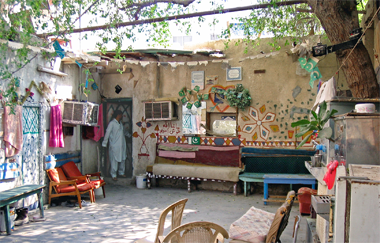
Although this is largely no longer the case, these groups of workers used to come into the country and be housed in the abandoned buildings of Doha’s inner ring. Nowadays, much of the accommodation is provided in the form of new-build constructions which do not have the character or many of the benefits of the older housing – particularly the courtyard houses, an example of which is shown here. It is interesting to see how the Pakistanis living here have decorated and equipped their home with a water cooler and refrigerator on the right, small national flags to remind them of home, and significant geometric patterns, a vase with flowers, printed phrases from the Holy Quran and a written exclamation for awe – maa shaa’ allah. Around the courtyard are a collection of unmatched furniture enabling them to sit companionably when not working. There are more images of this type of housing on the page looking at external majaalis.
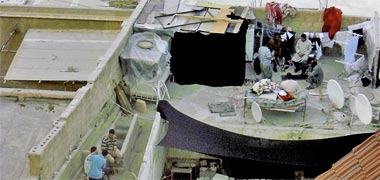
These expatriate groups would employ one or two of their group to provide tailoring and cooking for the whole group. Familiar cuisine and the ability to turn out well on Fridays are certainly two of the prerequisites that should keep workers happy. In this photograph a group of expatriates sit and stand comfortably on a roof inside the inner ring of Doha while, on the left, one of the men appears to be having his hair cut. This will be a group working together during the day and deriving a degree of relaxation from their shared and common bonds which, to some extent, will take their minds off their need to be in a foreign country in order to make the money to support their families at home.
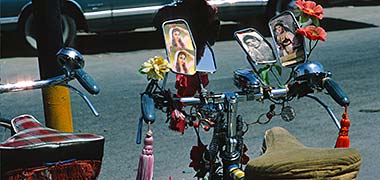
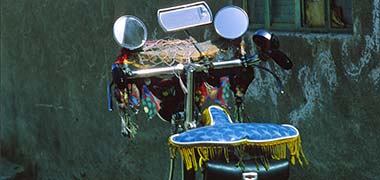
With the expatriates come many of their socio-cultural habits which may seem strange at first glance. It was noticeable in the 1970s that many of the Pathans who obtained bicycles decorated them in a similar manner to vehicles in their home country. These two photographs, taken from a number made in the early nineteen-seventies, show two different approaches to the use of mirrors. In the first the mirrors have been used to frame photographs of female Hindi film stars. Plastic flowers, tassels, a decorated seat, frame and mudguard add to the customising to create a very individual bicycle. In the lower photograph, there are certainly mirrors which I had thought on first sight to be more than necessary for all-round viewing but, on closer inspection found them all to reflect the rider. On other bicycles I have seen a combination of film stars and mirrors, again the latter reflecting the rider.
The ability to live together in national groups is an obvious benefit to expatriate workers. There is a degree of comfort and support which helps these workers adjust to the pressures of living in a foreign country. But it is not easy. It used to be possible to see how many of the groups showed allegiance not just to their own countries, but also to Qatar with the display of flags in the form of the Qatar flag, but green instead of maroon.
Generally this section of the notes refers to manual labour, but times have changed and there are significantly larger numbers of expatriates in Qatar now, and in all classes. Management and professional classes are heavily expatriate, and each creates their own socio-cultural grouping replicating in many of their aspects, their home environments. This produces a number of facilities which were originally alien to the peninsula but which have become fixtures there using customised spaces and schedules for their enjoyment. Some of these have been adopted by nationals, but in many aspects there are difficulties created by these imported activities, many of them conflicting with the traditions and customs of the peninsula.
more to be written…

But inflation is a problem all over the world. It affects expatriates disproportionately as they are usually tied to relatively short fixed term contracts and have little or no negotiating power. This is certainly true for labourers but is also true for other groups. This headline might obtain at any time but in August 2008, the rising cost of living in Qatar saw the newspaper article illustrated here. The article stated that the average monthly expenditure of an expatriate family has gone up by over 46% to Qrs.13,329 between 2001 and 2007. The proportion of this relating to housing had risen over that period from 21% of that sum to 30.8%. I have to admit that averaging figures for expatriates is an extremely tenuous exercise as they do not form a similar profile to the nationals in terms of age and sex distribution, but it is interesting figure nevertheless.
more to be written…
Pressures
There are many pressures on expatriates. Some are obvious and would be known before they move to the Gulf, some found only after arrival, and others of which they might never be aware. The majority of people who travel to the Gulf do so with the intent of working. There is, at present, a relatively small number of tourists but they have little to do with other expatriates other than if they are brought out by relations, or those they come into contact with as part of the tourism system. It is unlikely that they feel any of the pressures of the expatriates living and working in the Gulf; but articles such as this contrast certain aspects of the socio-cultural environment for tourists with their experiences in other countries.
The first issue to note is the extent to which expatriate communities have their own socio-cultural systems to help and protect themselves in a variety of ways. These range from the briefing, exchange of information and assistance to the more psychological needs of those living outside their comfort zones.
One of the greatest problems perceived by expatriates is their unequal status compared with nationals. This is an issue all over the world, often considered to operate against nationals’ interests but, in the Gulf, definitely thought by expatriates to operate against them on a number of different levels. For instance, the announcement of fines for wasting water has raised a number of comments, essentially complaining that it would affect only expatriates as the Kahramaa inspectors, who are expatriates, will not risk their jobs by attempting to impose fines on nationals. Whether that is true or not, that is the perception: and perception tends to be more dominant in the mind than fact.
Behaviour of expatriates
A general understanding exists within the different expatriate communities that there should be no misbehaviour in Qatar. Due to the manner of their employment and their need to earn funds to send home, most expatriates will try to behave in accordance with the requirements not only of their national and employment community, but also within the state’s laws and practices.
Companies have strict rules governing the behaviour of their staff, some maintaining their own security officers to enforce this. Embassies issue suggestions about behaviour in general, perhaps concentrating on behaviour in public, but usually reminding their nationals of the possible penalties for infringement, while bearing in mind the consequences of individals’ behaviour on the status of their mission. But there is little or no policing by embassies of their nationals in Qatar, even though some would like to.
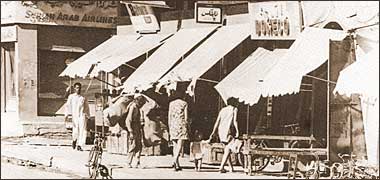
There is a common flouting of both laws and social codes by many expatriates, the latter a practice that can be readily observed almost anywhere in the country. There are certainly areas where ignorance creates problems, this being exacerbated when Qatari nationals have expectations that are different from the behaviours normal to expatriates in their various home countries. For instance, women’s dress is one such area where there is considered to be a lack of courtesy to the resident population. It is not unknown for nationals to make their feelings known openly and, certainly, it is discussed between nationals as an irritating issue.
However, there are other areas where there are habits or practices in the West that are not really understood, or which are now considered to be potentially dangerous to countries in the Arabian peninsula. Abu Dhabi, for instance has shown concern by arresting plane spotters recording the identification numbers of aircraft, and of an architect who was photographing buildings.

Plane and train spotting are well-known activities in the West, even if thought by some to be a mildly eccentric pastime. But the practice is a logical consequence for those who have developed a keen interest in the evolving design of aircraft and, perhaps, of the movements of aircraft around the world when it is felt necessary to record the flights’ registration numbers. Most airports in the West have people watching and recording planes and their movement in and out of the airport, some airports making provision for spotters.
Photography is now practised by many as everybody seems to carry mobile phones with a photographing capability. And social media sites such as Flickr have thousands of photographs of aircraft at or near Gulf airports.
It is also a feature of the Gulf states that their architectural structures are notable, some of them being in the forefront of architectural design. Again, thousands of photographs are taken of these new structures as a record of visits or as designs worthy of research and comment.
But it is not surprising that there should be concern by security authorities for the recording of buildings that they might believe to be at risk from terrorist attack. This is a subject that is widely written about with many experts believing that those who wish to focus on specific buildings or activities for criminal or terrorist purposes will do so, and will ensure they are not caught in the act. Unfortunately it is becoming more usual for photographers to be prevented from taking photographs openly in public as well as in private areas such as malls, ‘security’ being the answer given to those questioning the private guards.
Here there is an obvious conflict between the perceived needs of the security authorities and those promoting tourism. Each country wants to keep itself safe from attack, but at the same time is actively exploiting its new vision, encouraging people to visit and enjoy themselves. For those visiting these newly developed states there is an immediate wish to record their visits, and photography is the most immediate response, again witness social media.
more to be written on weather, exit visas, religion, cultural, moral, isolated communities, relationship between expatriates and tourists…
Tourists and tourism
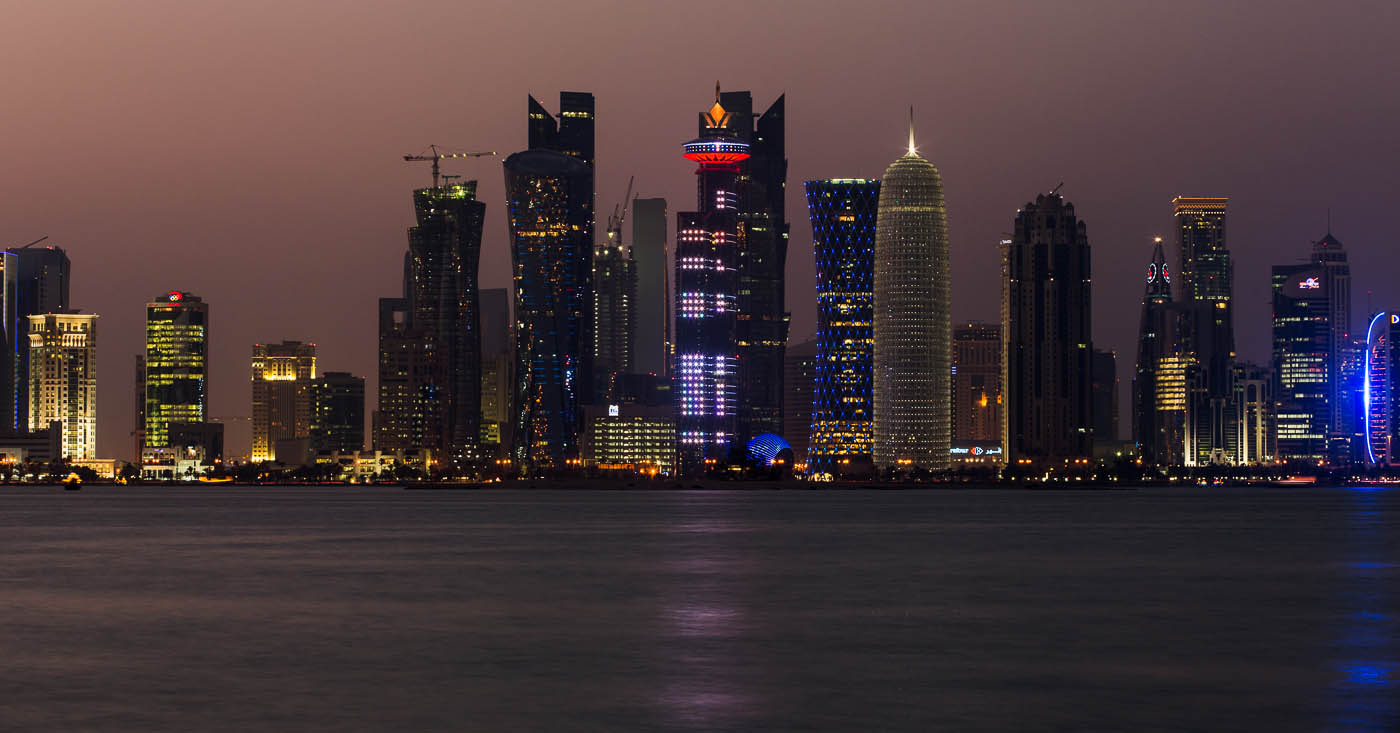
The most marked impact on tourists and newcomers when they first arrive in Doha is said to be, firstly, the surprising extent and pace of the construction activities around, particularly, Doha and, secondly, the contrast between new development and the remaining or reconstructed physical past. Perhaps the most extreme example of the latter is the dramatic view of the new building developments in the New District of Doha, particularly at night, where the lights within and on the new buildings suggest an interesting focus for the area and an attraction to visitors.

However, this attraction contrasts with the lack of interest there is for tourists within the New District when compared with the activities tourists might anticipate and experience in areas of similar visual density, such as New York or Singapore. The feeling of visitors who investigate the New District is that it is one for show or display, there being restricted pedestrian access and few activities or foci of suitable interest other than the buildings themselves, particularly at night. In this photograph the buildings are seen as a attractive backdrop across the West Bay viewed from an area of touristic relaxation, perhaps inviting investigation.
Not only is tourism a difficult activity to direct and control, it is also one that is hard to define when seen as an element of, or adjunct to education and cultural activities. The state recognises this and notes the difficulties in modernising while preserving the country’s culture and Arab identity. As such it is an important strand in their view of the future, this being an important objective of the national vision for 2030.
References are made in a number of official documents to the need to produce and implement a strategy that
is an integrated effort to ensure the country’s sustainable development by reducing its reliance on its hydrocarbon resources, while also placing it on the world tourism map and helping promote and perpetuate its people’s culture, values, and traditions.
While the efforts to integrate a nascent tourism industry into a rapidly developing state are admirable, it is not easy as there are obvious areas of conflict between the requirements of the industry and with those of other agencies, as well as cultural and educational difficulties that militate against the assimilation of culture, values and traditions into the requirements of the tourist industry.
Tourists nowadays are selective in their choices of destination. While there are few places or events that are not accessible to the potential tourist, they compete in their areas of interest and, of course, cost with most people wanting to obtain value for their holiday. Qatar’s tourism website suggests, in its ‘things to do’ list that
you can play world-class golf, cycle along hundreds of miles of desert off-road, take road-trips to beaches, hunt for fossils or get lost in the moment of a brilliantly crafted scene of desert dunes at the inland Sea
and specifically promotes the Museum of Islamic Art, Katara Cultural Village, Fort Zubara and desert camping and dune bashing. Whether the latter is consistent with the stated intent of safeguarding the environment may be debatable, and other countries have very similar opportunities for tourists. The United Arab Emirates, for instance, vies with Qatar in the activities available to tourists.
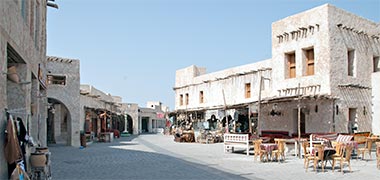
But the needs of tourists are also debatable, many requiring only a small degree of authenticity while demanding access to the more familiar aspects of Western taste and culture. In this way, the authentic experience can be substantially diminished such as it is argued to be in suq Waqf. While the re-built suq has an architectural similarity to the original that preceded it, the activities are different. There are now a significant number of commercial additions – restaurants, art galleries, gift shops and the like – that did not exist in the original suq and create a different, more sanitised feel. For instance, shops that sold traditional fragrances now also must sell modern perfumes, while artefacts are now produced specifically to cater for the tourist market. Contrasting with the ‘authentic’ suq are the glimpses seen immediately adjacent to it of the new constructions of the state, significantly different in concept, scale, material, character and detailing from traditional architecture of the peninsula.
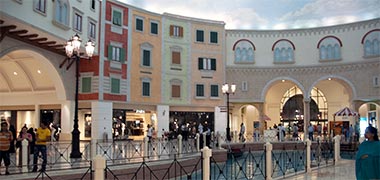
New developments – and of these there are a number – use pastiche and a foreign design vocabulary to induce in both the tourist and the expatriate workforce, an international flavour to their surroundings, suggesting a degree of safety in this familiarity. For instance, a quasi-Italian vocabulary is notable in many of the residential and commercial developments. But, as is argued elsewhere, this does not promote a feeling of safety within a Qatari or even Arab culture, but in an Italian culture. Moreover, it is illusory. Not only does it alter the physical framework, it diminishes something of the cultural framework within which Qataris live and work, taking from them a significant element of their heritage.
Tourists, and those who travel, are increasingly presented with comfortable, artificial environments promoting safety and security while presenting the bored traveller with retail opportunities. These settings, in accordance with Koolhaas’ views on airports, have an international feel to them while being transient in essence, surrogates for the city where both tourists and locals may wander at will, though not all being able to afford to buy.
more to be written…
Servants
There is an important distinction to be made here for Western readers in understanding what are meant by the term ‘servants’. Further down the page I use the term more in its accepted Western sense, but elsewhere on this and other pages I have written about the way in which families live together and share household duties, some of those members of the family perhaps having more of a service role to an outside observer. The family should be understood to include others who may not be related, who may share this role, but are considered an integral part of the family.
This may be true also of those brought up with the children of the household. These might include some who are brought into the household either as children of people who are servants of the house, or of widows with their dependents, in effect forming a service relationship but, within the wider context of the family, being an intrinsic part of it. Where these children are male, they will enjoy most if not all of the benefits of being a part of the family and, in the higher areas of the society, they will be treated in much the same way as if they were the children and, later, the adults they live with.

There are a number of memories I have that typify the concept of servants and the relationships to be found within families, particularly the larger families. This photograph is typical of one of the common sights I can recall: three men sit comfortably outside the entrance gate to a compound, passing the time of day. One of them is a Qatari, the other two perhaps gardeners, cooks, gate-keepers or guards. In essence it doesn’t matter really what they are, but what they represent, and that is a group who have a relationship with the compound and the people who live in it, and those who visit as guests. In a sense you are looking at a majlis, albeit in an informal and small form, but that is how information was traditionally passed and, of course, still is. Interestingly, behind them can be glimpsed the end of a dikka complete with rug covering, which might be considered to represent the next step up in the majlis chain.
What I have written above is a relatively simplistic view of the family and its servants. I shall attempt to write more on the complexity of these relationships later.
more to be written…
Many Qatari families have had and, increasingly, have servants to help in the running of their households. The reason is that servants are affordable due to the number of men and women seeking work in the Gulf from the Indian sub-continent and other regions to the east of the Gulf. From time to time there is a change in fashion as another country is discovered to have people who are willing to work in the Gulf and possess qualities that commend them. One of the latest has been the import of Nepalese. Honesty, diligence and a modicum of skill are the basic requirements, but the ability to speak Arabic or English is also necessary depending upon what the intended work is. It should also be understood that many expatriate families employ servants.

The selection of expatriates to work in the private sector tends to be based on whether they are to help within the house or only outside. Those working inside nowadays tend to be from India and the Philippines, those outside from Pakistan and Afghanistan where they work as gardeners, gate keepers and drivers. Those inside are mostly women, those outside are always men. However, staff may also work in private offices as well as in the home. In these cases the selection seems to have much to do with the character, capabilities and versatility of the individual. In some cases, such as gardeners, these are shared between a number of households, some of the gardeners also having jobs with government agencies and working in their spare time within the private sector.
Families have always worked together at the various tasks necessary for the smooth running of their households. The extended family has been, in this respect, a natural working unit, all members helping in its business. But, in the past, slaves were brought into the Gulf from Africa where there was nobody capable within the family to carry out that work, or to carry out work that was either difficult or where there would be increased return from a larger workforce.
The increase in servants, while obviously assisting in the running of households, appears to have created a number of problems for Qataris. These difficulties arise not only from the training, education, skills, habits and attitudes of the servants to their work, but also from the attitude of Qataris to having the staff live with them.
There is rising concern within the Gulf that foreign labour should be reduced although, paradoxically, there appears to be a progressive requirement for servants to perform an ever-increasing variety of tasks in and about the house. In Oman, for instance, where the expatriate work force comprises only forty per cent of the total in 1989, the Sultan exhorted his people not to be ashamed to take on menial work in the service of their country as it denied them their roles and opportunities within their society, as well as perpetuating the need for foreign labour. It is difficult to see how this trend is to be reduced in the area of domestic service. In fact, overtly or covertly, there seem to be a number of good reasons why foreigners are preferred, and why this is often extended to a preference for non-Muslims and English speakers.
Non-Qataris can be paid low salaries that are, nevertheless, higher than those that might be obtained in their home countries and, consequently, attractive to them as well as employment agents both in Qatar and their home countries. Where domestic employees are non-Muslims they are not considered a threat to the household’s practice of Islam, and proselytising would be cause for immediate dismissal, or worse. Servants would be foolish to gossip or, if they do, it is likely to be only to their own nationalities, and unlikely to become current within Qatari society. An incidental consequence of this is that a considerable amount is known about the operations of Qataris within expatriate communities.
Domestic servants are also poorly paid, a government labour force sample survey states, revealing that their average pay is a tenth of that of a government worker and that, with no protection from labour laws, their working hours are not protected with their working, on average, fifty-seven hours a week.
Where servants speak English, or another popular language other than Arabic, they will be able to impart that language naturally to the children in their charge, and English is the lingua franca of the Indian sub-continent and nearby regions. An unfortunate consequence of this policy is that the English picked up by Qatari children usually has basic errors in terms of both accent and grammar, and that can’t be eradicated by later, formal teaching.
Many of the servants coming to Qatar are qualified in areas other than those for which they find work in Qatar, but economic circumstance requires that they move to fund their families living in their home countries. This in itself can cause difficulties with attitude to work and can be exacerbated by social contact with friends, relations or other nationals working in the country. Certainly the service population look for opportunities to meet their compatriots and this can cause difficulties between employee and employer. The comparatively low salaries together with delays in payment and poor living conditions combine to induce at first resentment and then an aggrieved attitude towards both employer and country. Additional methods of earning money are sought and this can lead to police action either due to the nature of the alternative method of earning, or to the employee breaking the terms of his or her work permit.
Attitudes to work vary but it is interesting to observe the manner in which servants perceive and carry out their work. Employees seem to have an overwhelming desire to ensure that they are irreplaceable. This tends to be demonstrated particularly in spoiling children, specifically the boys of the household who are treated as being more important than the girls, regardless of age. Constant cosseting, a lot of physical contact, the use of sweets and soft drinks as reward and comfort, make the job of the mother far more difficult, and the child more spoilt. Conversely it makes the servants’ job no safer as they are often treated badly by the children with no recourse to the parents for intercession.
This relationship between servants and children is also notable in that it rarely seems natural for the reasons described earlier, though I admit this might be due in part to my own preconceptions. The relationship follows the pattern of traditional family life when members of the family who had been divorced, or were poor or in other ways needed assistance, became an accepted part of the family. This would also include, in the past, the use of slaves where they, too, become in many ways otherwise indistinguishable elements of the family.
The servants who take on the responsibility of looking after the children have different relationships with them depending on the age of the children. It is nearly always female servants who look after children of both sexes, and this relationship continues with boys until the age of about seven or eight and with girls a little later though it is extremely difficult to put a rule to the practice as it differs from family to family, maturity of the children and their relationship with their parents. With boys I have suggested an age when there is an increasing strong relationship between a boy and his father, with the boy being gradually introduced into men’s society and with his understanding of his role as a man becoming more palpable in his relationships with the members of his family, particularly with his sisters.
In the past, when houses contained just rooms with no notional function servants, like the family, slept wherever circumstance required. Nowadays servants tend to have a room of their own but will often sleep in the bedrooms of the children in their care, or even in the corridor outside. Whether this is an economic necessity, a practice arising from the servants’ need to feel safe in their job, a concern for the children in her charge or requirements of the employers, it is difficult to say; I suspect a bit of each.
This practice is even more marked when the family is travelling. Here, perhaps, it might be thought to be more of an economic imperative, but with disposable income not always being a factor, it is perhaps more of a true guardian’s role in safeguarding young children in a transient environment.
Many of the foreign domestic staff in Qatar are despondent, demonstrating their unhappiness in a number of ways, but the State will continue to attract foreign staff, particularly from south-east Asia and the Indian sub-continent, in order to cater for the various requirements of its nationals. Foreign governments, from time to time, attempt to embargo the use of their nationals as servants abroad, but this rarely lasts more than a few months as the need to maintain political and economic links with the better-off Gulf States continues to propel domestic servants into the Gulf. There is, however, an increasing level of intervention on behalf of nationals who have been mistreated, and at least one embassy attempts to insist on a minimum wage for domestic servants.
The attitudes of servants to rubbish and dirt are interesting. Perhaps due to the manner in which they were brought up they do not perceive these in the same way they are regarded in the West, and it is perhaps a paradox to see how clean the individual is in his daily laundered clothes operating in a less than clean environment. Cleanliness is not equated with hygiene. Thorough cleaning is required by houseowners but rarely effected, and never seems to be volunteered by employees. Dirt is moved out of the way but not taken up and moved off site. Dust is flicked off surfaces where it is visible and falls nearby. Commercial polishes are only used rarely and often are wrong for the job for which they are used. Hard surfaces are washed daily if possible and a lot of water is wasted in this manner.
I have written more on this below, under Serviced population.
Slavery
This has always been a delicate subject to discuss, whether in the Gulf or elsewhere. In Britain the Abolition of the Slave Trade Act was passed by Parliament in 1807 and this was followed in 1833 by the Slavery Abolition Act which outlawed slavery in the British colonies. This created the impetus for the British to deal with slavery in the Gulf.
The nineteenth century saw the British nominally as guardians of the Gulf – though this was not a view universally held, even by the British who found that their attempts to stop the illegal trade were continually thwarted by more manoeuverable Arab dhow s and a combination of subterfuge and armed resistance. The trade had come about due to the need to feed the growing date and pearl markets in Europe and the United States, the slaves being brought from the east coast of Africa. But this had been declared illegal in treaties made with Gulf rulers in the mid-nineteenth century and the British were constrained to stop the practice. This proved to be virtually impossible due to two factors:
- firstly, the great demand and the consequent efforts made by slave traders to fulfill the requirements of the nascent industries and,
- secondly, the turbulent state of the British parliament combined with the different agencies involved in running this part of the British Empire – the Admiralty, Colonial and Indian Offices.
It’s perhaps also worth mentioning in the first case that the Gulf was not the only place where indecision and the lack of an informed British public allowed this practice to be perpetuated. Albeit a hundred years earlier, Moroccan pirates captured and enslaved thousands of Europeans and North Americans with the relevant governments doing little to stop the practice or free and return the slaves to their home countries.
In the Gulf slavery continued into the twentieth century, though not to the extent commonly believed in the West. Writing in the nineteenth century, Colonel Pelly had noted that there were only two industries in the Gulf, slaving and pearling and, in 1924, the British Resident in Bahrein wrote that there were still slaves being introduced to Qatar with a tax of eighty Rupees per head. In line with their policies, the British continued to resist the practice and manumitted slaves wherever possible. The difficulty with this was that there were few places where manumission could be effected, the nearest to Qatar being Bahrein. In certain cases slaves were manumitted by their owners but, chiefly, slaves had to escape in order to be able to obtain their freedom.
In Qatar the practice continued after the Second World War mainly as there was little done to suppress it. It has to be said that slavery was not particularly onerous in the Gulf by the twentieth century, there being a number of cases where slaves were manumitted but continued to live and work with their previous owner. Slaves were seen as part of the family and intermarriage was not uncommon. Certainly this was the case when seen by outsiders and, to a large extent, slaves shared the benefits and disbenefits of their families quite naturally. The last years of informal slavery can be seen to have been benign.
Talking with Qataris about this element of society can be difficult, but it is often what was not said that was interesting and informative. What is noticeable is that freed slaves can be seen in certain areas of society such as the security forces, music and dance, these latter two areas being discussed elsewhere.
Diving and pearls
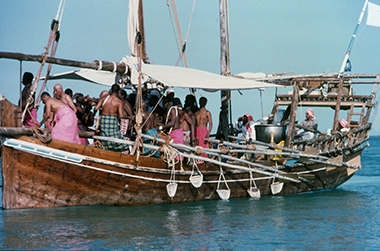
Pearls have been at the heart of Qatar’s existence for centuries. It is difficult to underestimate their importance not just as a commodity, but as a driver and regulator of the lives of the people living in the peninsula. Its situation mid-way along the Gulf, and the wide distribution of pearling banks around its littoral, made Qatar an extremely important element of the Gulf pearl economy. This image is one of a number of photographs issued by the Ministry of Information in the 1970s publicising the State and its history.
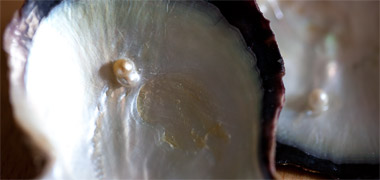
Once the slave trade was forbidden and piracy stamped out, pearls became the chief industry of the peninsula, and the main source of its wealth or, rather, the wealth of its pearl merchants and their business partners. This seconds photograph shows pearls that have attached themselves to the shells in which they were found and, as such, are unusable. From the photograph below it is possible to see something of the range of colours in which they occur, but in this photograph the two pearls which have agglomerated can be seen to be distinctly different in colour.

The richest pearl banks were located off Ras Rakan, the north tip of the peninsula, so Qatari merchants were in a good position, literally, in order to be able to obtain significant value from this industry. It was crucial to those living on the peninsula and created a significant attraction and benefit to those settling there. This sketch illustrates the position of the main pearling banks. It is evident that Qatar’s long north and east shore line was close to a large number of the pearl banks compared with those north of the eastern Gulf Emirates.
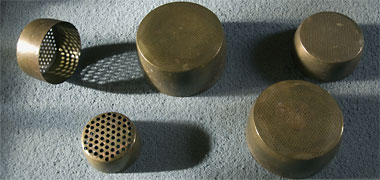

Natural pearls are some of the most beautiful natural objects to be found. They have both a tactile as well as a visual quality to them. It is no surprise that those who won them appear to know every one that passes through their hands, together with the detailed story behind each. As such they were appreciated not just for their value, but for their individual character and beauty as well as their history, some of the merchants are reluctant to sell pearls that have significant meaning to them. In a sense a significant element of the history of the peninsula can be described in pearl collections such as these. In the lower photograph, taken from a film made in 1966, a group of merchants are looking through their collections, some of the pearls being held in sizing sieves similar to those in the upper photograph.
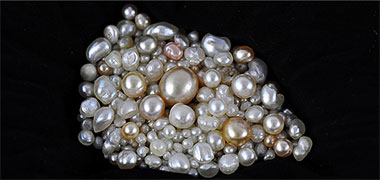
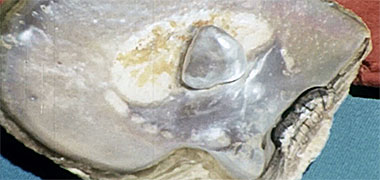
You can see in the pearls shown in the first photograph something of the range of colour and shape that characterise the pearls found in the Gulf around Qatar and the other Gulf States. Sadly for those associated with the trade, there was a severe downturn in Qatar’s pearl market around 1907, followed by the 1927 depression and the Japanese cultured pearl industry taking the market away from the Gulf in the 1930s, creating a more regular pearl, one which could be grown to order. You will see that a number of these pearls shown here are irregularly shaped and unsuited to stringing as a pearl necklace of matched, graded sizes and similar colouring. Known as baroque pearls, they still have considerable beauty with many preferring them to regular, matched pearls. The lower photograph shows a decidedly baroque pearl, still in its shell. I have seen Qatari dresses heavily covered in patterns of baroque pearls sewn onto them, and utilising a variety of shapes and coloured pearls.
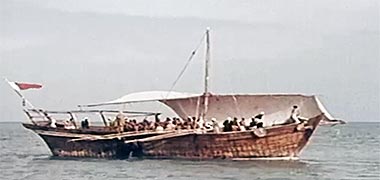
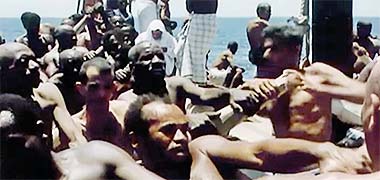

This first photograph, taken in 1966, shows a pearling dhow with it oars shipped, the pearlers singing, one of the characteristic folkloric activities now being developed both to retain a record of this element of the peninsular history, but also to entertain visitors, guests and the like. Dancing and singing of pearling is a regular feature at many events, private and public. Like the sea shanties sung by sailors on traditional, sailed, ships rhythmic singing developed with the need for the crew to carry out activities together. Commonly this would relate to heaving anchors, setting sails and rowing, but it was also an activity the crew would use to relieve something of the tedium and hardship of pearling. Note in the lower photograph the number of crew – three or four – required to pull each of the heavy sweeps, an operation which is carried out standing. In the lower of these two photographs of crew at the sweeps, there appear to be only two men at each. Due to the height of the deck above water, and the fact that the sweeps are operated from the deck, the sweeps have to be operated at a considerable angle requiring those at the end of the sweep, where the moment against the masaanid al majdthaaf is greatest, to handle the sweep at quite a height.
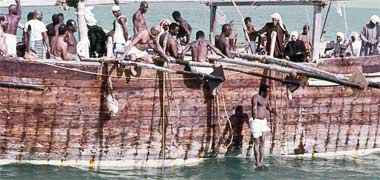
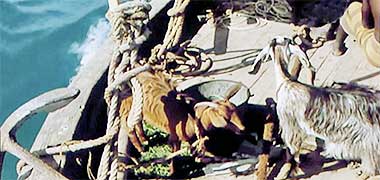

This is one of a number of official government photographs published in the early 1970s both in a book and as postcards and, I believe, a film shown on television. It shows a pearl diver entering the sea to begin his search for pearl oysters on the sea bed. More commonly, the divers would stay resting in the water by the side of the dhow for a number of dives, dropping to the sea bed from there. The photograph, and those above, also give an indication of the numbers of crew customarily used for pearling dhows.
The crews consisted of divers and oarsmen, but there were also specialists, particularly cooks with animals being carried in order for the crew to be given fresh food to keep them healthy as well as giving them a change from fish. It was not always possible but, where it was, supplies were provided from the shore, and this would also apply to some items that might need providing or mending when this could not be carried out on board. These two photographs show a pair of goats eating on deck and, below them, the dhow–s cooking fire set in a metal tray in order to provide an element of safety, and with a coffee della being taken from it.
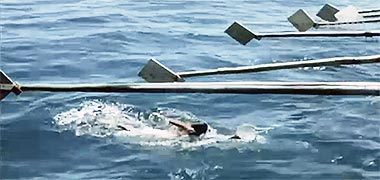
The diver would enter the water wearing a nose clip or fatam, and carrying a net basket attached by a line to the dhow. They use the basket to carry the oysters they find. When they have exhausted their breath they use the line to signal to the hauler on deck that they need to return and he will help their ascent, pulling them up and to the boat where the oysters will be collected and the diver return to the sea bed.
The life of a ghais or ghawwass was hard. Customarily he would spend the whole of the pearling season out at sea in order to maximise the number of pearls won from the pearling banks. There were three seasons for pearling, the main one, known as ghaus al-kabir beginning around the second week in May and lasting the whole of summer until around the third week of September when the date season begins. This main season was preceded by a ghaus al-barid which might last around forty days. The main season might be followed almost immediately by radda, a shorter season lasting around three weeks. The fourth season was winter when, rather than taking the boats out, pearls are won by wading in the shallow waters, a practice known as mujannah. Pearls won this way are not of the quality found further out at sea but had the advantage of being untaxed.
The boats remained out on the banks, and the divers worked from dawn to dusk, sometimes to considerable depths and making up to fifty dives a day. There might be a break in order to re-supply the boat or make repairs, but the need for this was dependent upon a number of factors, the owner and naakhuda preferring to keep the boats out to maximise their returns. There was also the possibility of a break in their time at sea if raiders approached their villages when a watchman would raise an alarm and the fleet would return to protect their animals and homes. Those in the villages would retreat to protective towers whose entrances were elevated some distance from the ground. To give some degree of protection against this and, more particularly, piracy, the British navy patrolled the Gulf during the pearling seasons.
The boats were captained and crewed by a variety of men from the littoral villages, the hinterland as well as from Persia, the Indian sub-continent and Africa. In addition to the naakhuda and the main crew of ghais and sa’ib there would also be a cook and, often, a drummer and singer, naham, employed to benefit the crew.

Here are a group of divers in the water, each wearing a fatam or nose clip, and apparently resting before making another dive. They will place the oysters they find in the small nets, or diyin, hung round their necks. The photograph also shows their guide ropes which will be held by a sa’ib on board their boat. It is likely the photograph was posed as divers did not descend together, but went at their own pace, holding their breaths for different times, two minutes being relatively normal.

The second photograph, taken from an official Department of Tourism poster of the 1980s, also posed and shows a diver resting on the surface with the fatam sealing his nose. The fatam was traditionally made from turtle shell or, more recently, from wood. Its particular characteristic is to have a degree of flexibility or spring to grip the nose without breaking.
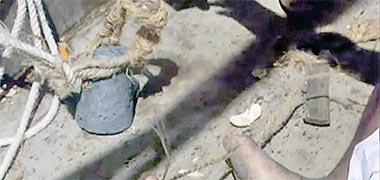
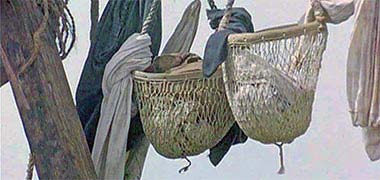
A number of coir ropes are associated with each ghais who will have two associated with him when in the water. In addition each diver will have a zabeen which has a loop on it in which the diver places his foot as well as a stone weight, hasa, attached of around four to seven kilograms to help him drop to the sea bed. The diver’s partner, the sa’ib pulls this up when the diver has reached the sea bed. When the diver needs to move to the surface, either because he has filled his diyin or has reached the limit of his lung capacity, the sa’ib will bring his diver to the surface by pulling on the second rope or hadaa which is attached to the diver’s waist. The divers also wore ear plugs to assist with the problems of the pressure of the water at depth as well as khabt to protect their hands.
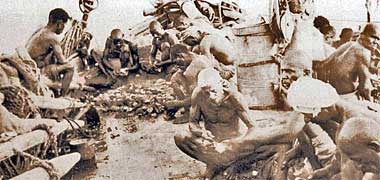
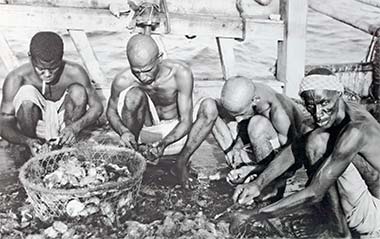
Once the divers brought up the oysters from the sea bed in their net baskets, the sa’ib would place them on deck where they would be left overnight in order to weaken the muscle structure holding them closed. The crew of the boat would set about opening them in the morning using their knives, and removing any pearls found under the supervision of the naakhuda, the master in command of the pearling craft. In addition to finding and saving the pearls, any particularly good examples of mother-of-pearl – the nacre lining – would also be saved for decorative work.
These two photographs were both produced by the Ministry of Information and published in a variety of other forms as well as, later, online. They illustrate something of the conditions on deck with the men working in groups and the discarded shells put aside for later dumping back into the sea.
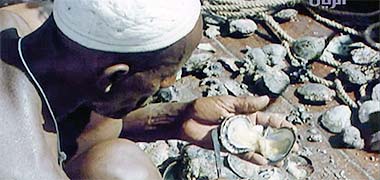
The naakhuda was the individual responsible to the owner for the pearling operation of his craft and was selected on the basis of his experience, knowledge of the pearling beds together with his maritime skills. As master of the boat he was also responsible for selection of the crew and their behaviour during the season, putting him in a position of considerable power and responsibility. Traditionally he would sit at the stern of the craft in order to be able to keep an eye on all the activities on and off it.

When pearling in the Gulf was controlled by Persians in the eighteenth century, the oyster shells were taken ashore unopened, the opening being subsequently carried out the under supervision of a Persian officer. Generally the opening of oysters was considered to be a matter of trust and theft a matter of shame, not just for the individual but also his kinsmen and tribe.

As master of the pearling boat the naakhuda was also responsible not only for the winning of pearls, but also for ensuring that the crew were able to operate for the period of time they would be at sea. This required that the crew had sufficient provisions for their time at sea and he, or more usually, merchants would make loans to the crew as advances against the eventual sale of the pearls. Because of this the success or failure of the pearling season had an immediate effect on the people of the Gulf. This applied not only to those winning the pearls and their families but also those relying on their value – the government who took taxes and the merchants who traded in the pearls as well as those supplying goods.
The terms of the divers’ service were severe and might require them to spend years tied to their work in order to pay off debts accrued. Profits in the nineteenth century were apportioned with 20% being shared between the owner and captain of each vessel, 30% to be shared by the divers, 20% by the rope holders and 30% going towards provisions. The shares that went to each ghais and sa’ib would only be known at the end of the season when they would attempt to pay off their debts as well as buy necessary goods and presents for their families. Finally, at the end of the season, the crew would have to obtain a release from the naakhuda in the knowledge that they would most likely have to sign on again for the next season.
There is a little more detail established in a folder of documents assembled by British political interests in the early 1930s. Although they especially relate to the Bahrein pearling industry, it is probable that the practices described would also relate to Qatar if not elsewhere in the Gulf. It is notable that some of the terms vary from those I have heard used in Qatar, but whether this is a regional, temporal or dialect issue – or a combination, of course – I can’t say but it is noticeable that there is a requirement that stated nawaakhada with shi’a divers must land them ‘on the 4th Muharram and take them off again on the 11th of that month’. This suggests a strong Bahreini influence with its high proportion of shi’ite population.
According to the documents there were, at that time, four types of diving system used to differentiate the relationships within the pearling operations:
- Under the amil system the sea naakhuda finances his enterprise from the land naakhuda or taajir. Neither the taajir or the naakhuda charge interest on the money used to finance the pearling operation and, in return for putting forward the finances, the taajir has the option of purchasing all the pearls from the operation.
Compared with the eighteenth century Persian system described above, oyster shells were opened and inspected for pearls each night under the supervision of the naakhuda. On returning to land or with the arrival of tawasha boats – usually jalaabeet – carrying buyers, the naakhuda might sell them, with the knowledge of the crew, for the best price he might obtain. Two-thirds of the crew must be present to witness this operation. The document states that some of the pearls might be withheld and sold privately by the naakhuda, suggesting that the operation of selling pearls was open to fraud. - Under the madyan system both the land and sea naakhuda charge interest, with the pearls being sold to anybody. Apparently the taajir often compels the naakhuda to sell to him, though this is wrong.
- With khamas there are no advances made to divers and the pearling is a joint operation which several men being part owners or sharing a diving boat. One of the men must be appointed naakhuda with the responsibility for keeping the accounts. Under this system, the naakhuda receives a half of one fifth of the profits, the remainder going to the divers.
- Under the azal system, three or four men either hire or own a boat, or are contracted to one man, or go independently on the boat of a naakhuda. Capital is necessary for this character of venture, but is said to offer the least opportunity for cheating.
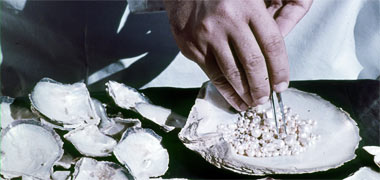
On returning from the pearl beds the pearls were handed over to the merchants who would then go through the collection with the naakhuda in order to make the first assessment of the collection. Using a set of brass sieves, the pearls would be sorted for size and then for colour and shape, the most perfectly spherical being the most valuable, but the baroque – those with irregular shape – also having value, particularly in the local markets.
This was a hard way to make a living, but it was one of the oldest ways to earn funds from the sale of the pearls, usually within the Indian sub-continent. It was the foundation for the wealth of a number of the merchants in the Qatar peninsula. But the lure of the nascent oil industry and the burgeoning Japanese culture pearl market effectively destroyed this way of life.
Regulation of labour

Doha’s central suq had been for decades the major area for the country’s agents to bring their goods to shore and move them to their warehouses. Daily a foreign workforce could be seen moving heavy goods around both to stores as well as to vehicles taking them around the country. Between jobs the workforce would rest by their cars waiting for clients to hire them. But this kind of work was not confined to central Doha but could be seen all over the peninsula.
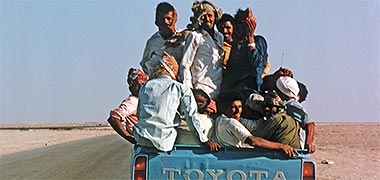
The introduction of servants and the cessation of slavery happened gradually, coinciding to a large extent with the increasing wealth of the country. Elsewhere I have written a little on the complex way in which the West understands the term ‘slavery’ and the manner in which it was conflated with servants and their integration within families. There were still a number of slaves in the country in the early 1950s but the beginnings of the oil industry and its concomitant construction and operation required an increasing number of workers. This dramatically changed the labour system in the country. The pearl divers, fishermen, farmers and badu herders discovered that there was better paid work in the nascent construction industry. Men commonly earning ten riyals a month could earn between one and four riyals a day working in the petroleum industry. This had a number of effects, two of the more important ones being that:
- firstly, it precipitated the move from the traditional industries of pearling and farming, and
- secondly, encouraged the introduction and development of labour regulations.
While the diminishing character of pearling was mostly the result of external forces, farming was a necessary activity for feeding those living in the peninsula, and the movement and introduction of expatriate labour were necessary initiatives.
There were no labour controls in the 1940s and 1950s. Wages, hours, overtime, holidays, treatment and working conditions varied considerably but the new industry required the establishment of coordinated labour regulations. The first workers in the industry were, by and large, Qataris, with pearl divers moving to assist in the off-shore work while drivers, cooks and roustabouts were employed from the urban and badu Qataris. Qataris and other Gulf Arabs also comprised the unskilled labour force though there was the beginning of migration from the Indian sub-continent to provide, in the first instance, clerks and middle managers under mainly British management, and from Egypt to work on the farms.
However, the initiatives marking the introduction of the new labour system was not without its problems, there being a number of strikes as workers attempted to improve their conditions. Some strikes were informal but a well-organised one in 1956 focussed not only on the British management but also on the Qatari regime, resulting in clauses being inserted into labour contracts making political activity illegal.
Despite the current difficulties, the conditions under which foreign labour is contracted, brought to the Gulf, housed, fed and work are greatly improved from those early days. For instance, and as is illustrated in the photograph at the head of this note, all labour used to be moved on the back of pickups and lorries for many years until the late seventies when buses were introduced both for the workforce as well as for students needing transportation to the increasing number of schools.

It was said that the introduction of buses by contractors led to a more professional approach by the labour force. Some of the newer employers reinforced this new status by making improvements in the housing and feeding of their workforce, their understanding now being that the better treatment of labour would produce an improved product. This, together with proper teaching of trades and skills certainly produced better constructions – where trained labourers were properly used.
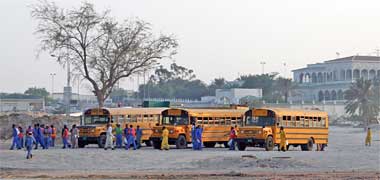

You can also make out in this photograph that many workers were being provided with protective clothing, in this case blue dungarees, though it was notable that many workers did not enjoy wearing hard hats and protective boots; flip-flops or traditional open-toed sandals continuing to be worn on many sites, as seen here in the lower image on the right.
Accommodation has been a problem, perhaps more so in other States where there is sometimes a considerable distance between housing and the workplace meaning little time for rest for the labour force. This has been a particular problem in Dubai, for instance, but problems in the Gulf associated with labour conditions are still apparent.
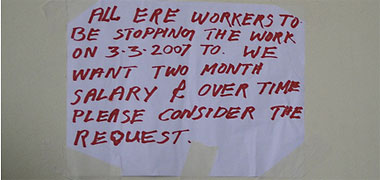
This has led to strikes in Dubai relating to both the amount of rest the labour is able to take as well as other issues, notably payment. This appears to be spilling over into Qatar as news items have noted. In this photograph, a rather poignant request has been posted in an expatriate labour housing compound, asking for monies believed due to be paid to them. Whatever the law says, and however it is applied, expatriate labour always feels psychologically abused by the system under which they operate even though, in general terms, there may be significant benefit with the remittance of funds to their home countries. Strikes, legal or otherwise, are their last resort but they risk at least losing pay while they are on strike. It is not easy for them.

Qatar, in common with most of the Gulf states, is very much dependent upon its foreign labour force to carry forward its ambitious development plans. Here an expatriate labour compound houses at a relatively high density, a contractor’s labour force in blocks such as this. It is neither the best nor the worst I have seen, and many will tell you that it is a significant improvement on housing provided in their home country if, of course, they are able to find work there. And the truth is that many are unable to do so but come to the Gulf in order to be able to make a living and support their families at home. But this and other, similar sites, are a reminder of the costs that some pay for development.

Work is hard in the construction and maintenance industry. Not only is it hot for half the year, but the equipment, training and protection of the workforce sometimes leaves something to be desired. In the upper photograph you see workers on a multi-storey structure taking a break from their work in the hot summer with no safety barriers to prevent their falling. Labour laws require workers to break when the temperature reaches a certain level, but that temperature is very hot and produces fatigue which, in turn, increases danger on site.

This effect is magnified considerably when the holy month of Ramadhan falls within the hot months of the year. During this month nobody is permitted to eat or drink between, roughly, sunrise and sunset. Workers will lose a considerable amount of body fluid even if they are working within a building. Just as difficult for the body is the associated loss of essential salts through respiration and perspiration. Here a group of cleaners are taking advantage of the relatively cool terrazzo floor to sleep. It’s not ideal, but at least it gives them a degree of relief and helps prevent or reduce some of the more extreme characteristics of water and salts loss.
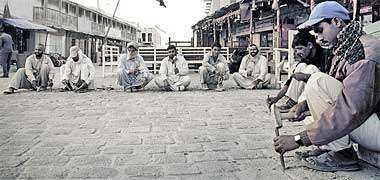
The workforce in Qatar has a wide variety of tasks to perform. Due to the character of rapid development in the peninsula, there is a considerable amount of skilled work to be carried out on the more complicated constructions, particularly those in the New District of Doha. But there are also less demanding tasks to be carried out in the construction of the large number of smaller projects as well as works associated with maintenance. Here a group of foreign workers work on repairing the paving in suq waqf, in the centre of Doha. The work is not demanding technically, and some of the workforce coming to the Gulf may have a different skill set, but many come for the financial rewards to pass on to their families in their home countries. There is work available at a variety of levels of skill for those who want to work.
All expatriate workers in the country have to be sponsored to enter. There is a note on the requirements under the Sponsorship law on the page dealing with the different pressures on the country.
Institutional development
The control of labour continued to develop in response to the perceived problems relating mainly to the oil industry. A labour department was established followed by a law in 1962 establishing preference for employing Qataris, other Arabs, and foreigners – in that order. The latter were required to be sponsored by a Qatari and to work at a specific job. At the same time the government attempted to encourage Qataris to work in the now well-established industrial sector, but the growing industries were requiring a greater workforce than could be assembled from either a Qatari or a combined Qatari and Arab population.
Not only was there a problem with workforce but the growing population – both national and foreign – required servicing and most of this had to come from abroad. Clerks, cooks, drivers, watchmen, gatekeepers, domestic servants, nursemaids, nannies, teachers, nurses and the like were brought in from abroad and this pattern continues to this day contributing largely to the situation where Qataris are a minority in their own country.
At the same time as the industry was evolving, the social structures in the country were being developed, mostly notably in education, in a sense exacerbating the labour problem. The educational system encourages Qataris to move into tertiary education, and it also treats boys and girls equally. The effect of this has been to move Qataris into the areas of management and to starve the system of Qatari technocrats. It is significant that Qatar University was established with considerable funding while only a relatively small technical facility continued its operation undeveloped.
For those not aware of it I should mention here that Qatar is one of the most liberal countries in the Gulf with significant impetus being given to the education of women and to the freedom of the press. Witness the establishment of al Jazeera, the news agency that has created such a stir round the world.
I should also add that Qatar, along with the other Gulf States and Saudi Arabia, has opened its borders not just to Palestinians without a home but to a number of other shaqiqa – Arab states with which Qatar has links, particularly religio-political links – and where there was perceived to be a need to allow relatively poor countries to benefit financially by their sharing their knowledge and technical bases through immigration to Qatar. Many of these Arabs moved into the teaching, managerial and service areas of both government and the private sector.
The increasing income from the oil and gas reserves has created significant wealth in the Qatar economy. Much of this is being spent on physical development, essentially servicing those who come to the country to service the economy.
Serviced population
Anybody reading the local press in Qatar will be aware of some of the strains that this rate and scale of development has brought to the country in terms of its domestic staffing. The most significant relate to the abuse of employees by employers, sponsors and manpower agencies. The mistreatment is of two forms:
- physical, this relating in the main to cruelty and assaults on maids and domestic servants, and
- contractual, the latter encompassing a range of complaints ranging from the withholding of exit visas, excessive hours, poor living conditions, withholding of pay, repatriation expenses and a number of related issues.
I don’t mean to suggest that the mistreatment and abuse is always against the servants or employees. This is not always so as a number of cases of theft, assault and the cheating of employers have been reported. It is not possible to comment on the scale this represents but there are a significant number of complaints within the Gulf to make them credible enough to be remarked on and registered by international agencies.
One specific element of the problem is worth highlighting as it affects all foreigners employed in the Gulf countries. Any expatriate working in Qatar is required to have a sponsor in order to enter and work. That sponsor takes a fee and has certain responsibilities. The sponsor keeps the passport of the employee and the latter is not allowed to leave unless he or she has the permission from the sponsor and his or her passport returned. For a number of reasons this is not always an easy process and creates significant psychological pressures on those who might feel they are trapped within the country. It’s also a process that is open to abuse, either deliberately of by neglect, and there are constant complaints about the system.
It appears to be particularly unfortunate when an individual has come to the country with the promise and anticipation of taking a job such as a secretary or salesperson, but has been offered work as a maid.
Conditions of employment
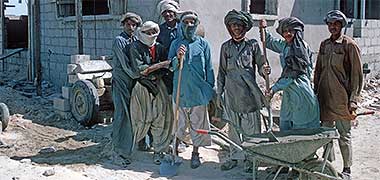
In many respects times have changed since the photograph of these workers was taken in 1972; but in other ways, much has remained the same. Theoretically the employment of servants and other labour within the country is benign. It is argued to benefit both those from countries with low employment opportunities as well as those needing domestic servants and labour to carry out, particularly, construction work. But it places a great strain on employees so far away from their home countries and cultures, even though there is some opportunity to contact and obtain support from fellow nationals and their embassies within Qatar.
Yet foreign missions have an ambiguous attitude to their nationals, needing to maintain a political direction and balance in line with their national directives, while dealing with their own nationals who, in the main, only come to them when they are in need or trouble.
One of the main difficulties that labour appears to suffer from is that of its expectations – though this can apply both to employer and employee. More recently there has been significant comment in the international press on some of the problems faced by expatriate workers in Qatar compared with the rules and regulations governing expatriates in other parts of the world.
As mentioned elsewhere, one of the most important aspects of Arab society is that relating to hospitality, and it is this tradition which is at the root of the problems now faced in parts of the Gulf. An Arab has a duty to protect and safeguard guests or visitors. This system, known as kafaala is now taken to refer to labour sponsorship though it has other meanings. However, the general concept is that of protection to foreigners, kafaala requiring a national to sponsor any individual working in Qatar – and, of course, for all expatriates to be sponsored.
In practice anybody coming to the country to work must both give up his passport to his sponsor as well as pay a fee to a kafeel, a person acting as the worker’s sponsor. Below this there is a layer of labour agents, both licensed and unlicensed, who take a percentage or fee from the payment made to the kafeel.
Many difficulties arise from this process as, in order to benefit from the wealth in Qatar and other Gulf States, potential workers will borrow or sell assets in their home countries in order to be able to afford the fees of labour agents operating there. It may even be the case that there are two layers of these agents.
Without their passports, it is impossible for a worker to leave legally. Sometimes, compounding this, workers may not be given identity cards which means they risk arrest and detention. Bearing in mind that there are a number of workers who have left the relative protection of their compounds to escape difficulties they have with their employers or their agents, there are now a number of illegal expatriates risking their futures while attempting to eke out a living. Some expatriates suffer psychologically in feeling trapped and perceiving their future to lie in the hands of others over whom they have little or no influence.
Just as seriously, some workers are not paid for months after arrival while having to reimburse people within the engagement system for their travel and accommodation. This can introduce extortionate rates for borrowing the necessary funds both in the Gulf and in their home countries with families being driven into debt. The Gulf States are attempting to do something about the problem, but the massive numbers flooding into the area make the resolution increasingly difficult to administer while allowing unscrupulous individuals to prosper in and out of the Gulf.
But conditions of employment are not the same through the Gulf. At the time of writing – November 2013 – Qatar and Saudi Arabia both required an exit visa for their expatriate workforce, while Bahrein, the United Arab Emirates, Kuwait and Oman didn’t. Generally speaking expatriates must be sponsored by a national of the Gulf country, though there are some exceptions, such as in the UAE where non-nationals may sponsor domestic workers. It is also possible in most countries for legal entities with national status to sponsor expatriate workers.
Compounding these problems, the notion of individuals having to leave and remain outside the country for a period of time prior to returning to work for a different employer has been an element of the employment mechanisms of many of the Gulf States, though this is changing.
Moving from one employer to another can be difficult. Qatar allows this but requires a time period and a certificate of no objection from the first employer, as do Kuwait and Oman with varying conditions; Bahrein allows it under different conditions, but not for domestic workers; and the UAE permits change only when a new employer offers better conditions than the previous employer.
A note has been written here on rights and duties applicable to employees.
The issues surrounding the employment of expatriate labour continue to be exposed, most recently in an Amnesty report highly critical of the legal system, its administration and enforcement. As a result of this the government has taken steps to remedy the situation with regard to the kafaala system, but this has been universally criticised as being ineffective. The new sponsorship law, no. 21 of October 2015, continues to require expatriate labour to obtain permission from their sponsors both to change employment and to leave the country. The former may leave labour in exploitative or unacceptable conditions, and the latter contravenes International Human Rights law. While it is likely to take a little while for this law to come into effect, it is probable that much will have to change with this additional exposure of the State in the light of the upcoming football World Cup and the interest it is generating.
more to be written…
Recruitment
The process of obtaining work in Qatar for domestic servants and others starts in their home country where a number of agencies are available to procure their services. This process starts the payments by the applicants as they undergo, in theory, at least medical, skills and aptitude testing for their suitability to travel and carry out the work for which they are applying. In many cases applicants are over-qualified but need the work so are prepared to take domestic work or lesser work than that for which they are qualified in order to be able to send money home to their families. Others are carrying on a family or village tradition and, to some extent, know what they are letting themselves in for.
In some cases Qataris will travel abroad to interview applicants or to identify new areas for employment. This is likely to be more successful for the employer and, hopefully, for the employee. In some cases a married couple might be employed, a practice that gives better stability to the foreigners and, consequently, better service to the employee.
There are recruitment agencies in Qatar as well and they usually have working relationships with foreign agencies and tend to be the agencies that have to deal with the local sponsors. According to Qatari newspapers there seem to be significant difficulties between domestic workers, sponsors and recruitment agencies, the latter believed to be the main financial beneficiaries, and most of these difficulties being associated with the management of expectations.
However, it is not until the employees are in place and beginning to learn what is required of them that the various problems bearing on their relationship will be revealed.
One problem area I should mention is the issue of qualifications. It is not uncommon in the West for applicants seeking work to suggest their qualifications are better than they might be. In countries where documentation of qualifications is well established, checking an applicant’s qualifications is not difficult, if a little tedious. However, there is a significant problem with many applying to work in the Gulf having spurious documentation. To a large extent this arises by the need for many to find work outside their areas of expertise but in a field for which there may be better employment opportunities. It is hoped that the agencies will sort this out, though it is commonly thought that they don’t.
A related issue is the conflict between government policy of their nationals developing the skills needed to consolidate government structures, and the self-interest of foreign staff wishing to continue to work in the country. It is not uncommon for foreign staff to insist on carrying out the work of national staff with the result that the national staff do not develop their own skills. This can coincide with nationals not wishing to carry out simpler tasks and it is difficult to distinguish the degree to which this problem is damaging government structures, continuing the dependence on foreign expertise.
In the past efforts have been made to encourage nationals to develop more basic skills, but this has not worked for a number of political reasons which I shall write about elsewhere.
Domestic staff
Generally non-Muslims seem to be preferred as male servants but Muslims as female. Where this is the case there appears to be little problem with male servants moving around the family side of the house. Their role can be wide-ranging as they will carry out work around the house as well as outside it, perhaps acting as a driver, watchman or gatekeeper though the latter two positions are relatively menial. The heavier work will be given them but this is not always the case. What is unusual to the casual Western viewer is the fact that men are allowed into the family area at all. As I noted above, it seems that this seems to be because they are non-Muslims and I believe that Arabs are also not hired for any work within the family side of the house. Certainly Qataris are not employed for this though there might well be a member of the extended family taking on a supportive role, though I’d hesitate to characterise them as being servants.
The women who are employed as domestic servants generally fufill a number of roles. Theirs is a supportive role in terms of keeping the house clean and organised, assisting or carrying out the cooking under the supervision of the women of the household whose responsibility this is and whose reputation is dependent upon the outcome of their cuisine. In addition they will have to fetch and carry throughout the day, a day that can be quite long due to the different hours kept by the older and younger, male and female members of the household.
The other important role they are often employed for is that of nanny. I don’t know if this is an official role or one that is an adjunct to their general domestic work but, for those that take on this onerous work, a good knowledge of English is considered necessary. My experience is that this is not always the case and one of the difficulties with this system resides in poor grammar, vocabulary and intonation being passed on to impressionable children.
A secondary problem has to do with the relationship between domestic servants and the children of the household. Many believe that Qatari children tend to be spoiled. I think this is a consequence of the dramatically increased wealth of families, peer pressure and, particularly, the natural characteristic Qataris have of generosity. But I’ve noticed that many domestic servants make themselves available for every whim of the children in their care and make no attempt either to maintain discipline or encourage good behaviour. I’ve not been able to understand if this is due to direction from the employee, a cultural issue or, as I suspect, an attempt to keep their jobs.
Nor do I know how the relationship between a nanny and child impinges on the familial relationships. It is commonly considered in the West that the use of a nanny weakens the relationship between a mother and her children, perhaps also with the father, though in the latter case I think this would be dependent more on whether the child was male or female. At the least this is one more factor in the complex issues that are affecting those within the country, particularly those that are due to the influence of the West on its Islamic society.
I have mentioned the issue of abuse further up the page, but one of the other difficulties noted in the local press is that relating to holidays and free time for domestic staff. Those who come from abroad have contracts describing their conditions of engagement, pay, holiday and so on but these are not always honoured. One reason for this is the complexity of contractual issues there can be between agents in the home country and those in Qatar, the clients and the domestic staff. Generally speaking, when the clients are reasonable people there are little or no problems, but when they are not the difficulties for domestic staff can seem insuperable. This is the case not just in Qatar but all over the world.
Employers generally permit domestic staff to take time off during the week, often on a Sunday to enable Christians to meet for prayers. Just as importantly, and on whichever day is taken, this allows foreign nationals to meet each other and maintain friendships, the system acting as an important support function. Nowadays domestic staff are also able to maintain links with friends using mobile telephones, a technology which has only lately come to benefit them but which is important as a method of keeping staff settled. By the same token it has also allowed expatriates to learn more of their rights and compare conditions and employers.
Staff who have suffered abuse have been able to call on others for assistance and, in other parts of the Gulf, this has led to accommodation being made available for those who have left their employers while the legal issues are settled. At present this appears to be an ad hoc affair but, as government systems are refined, it is likely to lead to a more effective and governmental process rather than remaining a private initiative. Newspaper reports are unclear on the extent to which these initiatives are effective, nor the extent to which foreign embassies are effectual in dealing with this problem.
Workers’ leisure and recreation
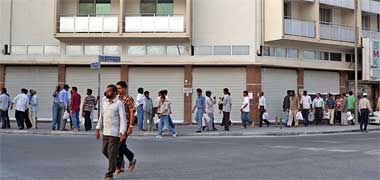
The expatriates who work in Qatar, as holds true elsewhere in the Gulf, do not have that much time available to them for leisure and recreation. There are government regulations covering employment and establishing rules for the benefit of foreign workers in the country, but a number of factors militate against their universal adoption or policing which has given rise to a number of complaints about the treatment of foreign workers. Even al-Jazeera, based in Qatar, has made programmes about this problem which they claim exists throughout Gulf. This impacts the time they have available for leisure and what they do in that time.
What is relevant with regard to the treatment of workers is that, in the view of those from the Indian sub-continent, there are two kinds of expatriate workers in the Gulf: those from the Indian sub-continent and those from Britain and the United States. This, of course, is a simplification but appears to be making a distinction between manual and white collar workers. There is no doubt that all over the world workers can be treated badly with regard to conditions of work and pay, and this is a personal issue. There are good and bad employers, and there are agents, contractors and sub-contractors who deal with the supply and treatment of workers, and who stand to profit in different ways. Where a system can be abused, it sometimes is. But the factor which seems to exacerbate the conditions of workers in Qatar is the climate. It is hot for much of the year, a condition which saps mental and physical energy, particularly of those from countries where this is not the natural condition, such as Nepal. However, it is not my intention to deal here with the treatment of workers, rather in how workers find leisure and recreation in the limited hours available to them.
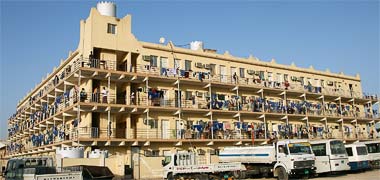
First it should be understood that the expatriate workforce lives under a wide variety of conditions. Some of their housing lies in the old urban developments left by the national population who have moved to larger, modern housing. Those old buildings are now used to house workers, mostly who are under their own control. In many ways these older buildings may be familiar to those now living in them, but new buildings have also sprung up specifically to cater for the influx of large numbers of expatriate workers. One such building is shown here. These structures may be new and function usefully for the owners, but they can lack some of the facilities the older structures contained.
The building comprises a series of rooms with peripheral balcony access, each provided with a wall-mounted air-conditioner. It is likely to house workers who come from a common origin and who share a similar socio-cultural background though this housing may not replicate the conditions in their home country or countries. There are two interesting aspects of these buildings. The first relates to how the balconies have become the meeting place for those living there though, being walkways, are not really wide enough for either casual congregation or prayer. The second is the manner in which the railings have been used to hang the workers’ washed clothes which illustrates both the lack of proper provision for this function as well as the character given to the architecture by the clothes. The general point to make is that these buildings do not generally cater for the socio-cultural habits of expatriate workers when not working. They are essentially, dormitories. Bear in mind that this will be a male-only development.
The majority of the workforce who come to Qatar and the Gulf, do so for money. It is a hard life but first there is work which may not be available in their home country and, secondly, there is money which can be repatriated to families back home.
Both men and women come to the Gulf. For the most part there are separate markets for the different sexes; at its crudest men tend to work on construction sites and women in houses or in retail outlets. Sometimes couples are employed but this obtains, in the main, for employment in domestic premises.
For those who work in domestic employment there is the possibility that they will have to work long hours to match the living pattern of the family employing them. The long hours are a difficulty but the fact that the work is carried out in a domestic residence may ameliorate this. But it is still sometimes difficult for them to get out of the house. Better employers give their staff the ability to go out and meet friends. Commonly the different nationalities will find time to be together and, with time, friendships are made or continued from relationships made in their home countries, this often being a reason for friends coming to the Gulf in the first place.
For men it can be rather different. The only times that the workforce can generally meet is in the evening or on Fridays, though this is not always the case. As the main reason for working abroad is the drive to make money, there is little disposable income available for expenditures. Generally, this means that leisure tends to be passive though I have seen both softball and cricket matches organised by workers.
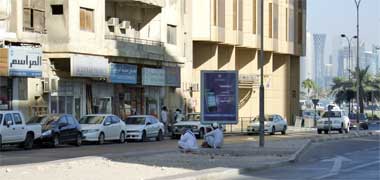
Passive recreation tends to mean that workers will meet somewhere away from their living quarters, and talk as they watch what happens around them. Here two men take time out of their day to sit in the shade on a median in the centre of Doha and relax. Many expatriates seem to be able to sit for hours this way and, while it may seem unfocussed, there is an importance to this activity, or inactivity which consolidates socio-cultural relationships as well as allowing time to pass in companionship. In a sense it’s similar to a majlis system though, in this case there are only two people involved.
In the evenings, particularly, workers tend not to sit for long periods but move around. Wadi Musheirib, for instance, always has a lot of people milling around and, on Fridays after the mid-morning prayers have been attended, there will again be informal meetings followed up by something similar in the evenings when the weather is a little cooler. When it rains workers tend to stay in their living quarters.
It is also significant that there tend to be informal rules about where people can meet each other. In the photograph at the head of this section, for instance, you will see only men as there will be parts of the suq where they may not go but where families can, this in order to protect the women of families who may feel uncomfortable with many men roaming around. This follows, of course, Islamic custom but also reflects the nervousness many feel with a large proportion of the overall population being men and unable to form natural relationships with women. Because of this an effort is being made to ensure propriety in the suq in order to protect the initiatives that have made it a successful tourist attraction.
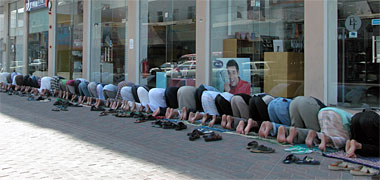
While it should not be thought to be an element of leisure or recreation, prayer for Muslims is a significant marker of passage through the day. During the day, and in working hours, those who work in shops and offices bond through the act of prayer. By this I really mean Islamic prayer as prayer times are dictated by the lunar calendar and are both a requirement of Islam as well as, to a small extent, a free choice. Wherever you go, whether it is in offices or shops or, as in this case, out in the open, you are likely to see men praying together at the appropriate times. Here a group of men from adjoining shops and showrooms with, perhaps, passers-by, are kneeling to enjoy communal prayer. Often in these circumstances, one man will take the lead, kneeling slightly ahead of the others. In this case it appears not to be the case, but it does illustrate how well individuals come together at prayer times and suggest how prayer breaks up the passing of the day.
more to be written…
Shopping and retail development
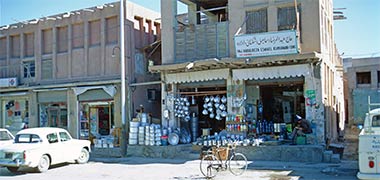
First, a brief note on the ways in which retailing developed in the peninsula. There is a little more written on shopping on one of the pages looking at the way society is organised spatially. This photograph, taken in early 1972, is of two of the traditional buildings on the east side Doha’s suq waqf developed for the storage and the retailing of goods required by the expanding households in the developing economy. This was the main area for the purchase of household goods for not only Doha, but much of the country.
Prior to the discovery of oil the main commercial activities in the peninsula were based on pearling, slavery and smuggling, all of this complicated by piracy which the British attempted, with varying degrees of success, to prevent. It is only relatively recently that there were permanent retail outlets established in the peninsula – perhaps three or four generations ago. Many of the traders were able to develop their wider commercial interests from their pearling activities as they had the infrastructure and contacts to facilitate this. Commercial links were made possible, particularly, within the Gulf and to the Indian sub-continent and many of those who settled on the Qatar littoral had their origins in these areas.

This saw the importing of the materials necessary for day-to-day living, mainly items such as kerosene, cooking oil, rice, tinned goods, flour and so on – this being collected from the main suq in Doha on a daily basis by those living in Doha and by others servicing the peninsula on a regular basis. As such there were no aswaaq in the scattered communities other than a number of ad hoc scattered retail outlets responding to daily needs and locating where the new entrepreneurs had their houses as illustrated by this photograph, taken in 1972 outside the centre of Doha. It might be considered to be the equivalent of the corner shop but would not necessarily be part of a group of outlets due to ownership patterns.
It should also be understood that such shops operated in accordance with the agreements of the community. Although there were no formal systems for requesting or giving permissions, the shops would need to conform with both communal and religious constraints. The new merchants would take it upon themselves to organise collection from the traders in the suq. These traders were often both wholesalers as well as retailers for the stock they were introducing to the country.
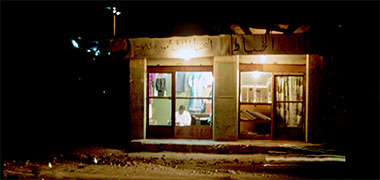
With time these single unit shops were expanded by their owners to take account of a variety of newly perceived needs, many of them introduced by the rapidly escalating numbers of expatriates coming into the country and replicating many if not all of the services normally carried out within the confines of the family household. In this photograph a tailor mends or prepares clothes for members of the expatriate community. In the national families this task would be carried out by the women of the family.
Tailors, such as this, might be employed directly by a Qatari to carry out this work, the national providing room and board for the expatriate within his family compound or in an owned or rented space such as that illustrated above. But it was not uncommon for groups of expatriates to be employed as, for instance, labourers, but to maintain one of their number as a tailor or cook, paying for the services of providing food and dress to their national requirements. I have no idea how the tailor shown here was employed, but he might well have been such an individual and given space to carry out additional work provided from the wider community and to his sponsor’s benefit.
There is a belief that it was the Royal Family or the shyuwkh heading the different family groups who were the main traders, but this was not necessarily the case as they would not like to be seen as being directly involved in commerce. Instead they would lend support and give de facto protection to the traders. So it was not the sheikh who would open a store, the pattern being that entrepreneurial families developed wholesale storage facilities in the relative safety of Doha or Wakra where not only were there State Customs posts, but also a degree of safety provided by armed guards until the early nineteen-seventies. The merchants would operate under the protection of the Sheikh who would be given benefit. In this there was a social difference between those of badu stock and those essentially settling on the littoral. Sheikhs would not want to be seen to be directly involved in trade.
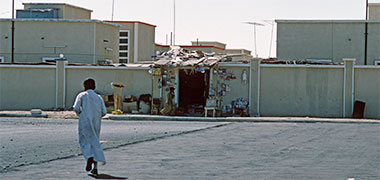
As the towns grew, shopping became more difficult due to the longer journeys to the nearest suq. While there were itinerant merchants carrying goods from door to door, the opportunity to open small retail facilities was an obvious way in which daily necessities could be readily stored and sold, introducing convenience to the neighbourhood and income to the owners. One of the ways in which shopping developed in the suburban areas was by the opening of small retail facilities. These were opened by house-owners who would convert their garage or, as here, just make a hole in their boundary wall and stock those amenities that were thought to be needed locally. In the first instances house owners opened their shop and worried about licensing from the Municipality later, this being, in time, regulated.
Generally the house owners weren’t the shopkeepers, but used expatriates to manage the shop, their duties also including keeping watch and general duties around the house and grounds and, perhaps, driving. Sometimes the owner would sit in our outside the shop, particularly in the evening, when the area became, in effect, a majlis for him, or for the servant operating the store.

In Doha the merchants developed their wholesale facilities, nearly all of them being located originally near the coast in order to be able to facilitate the movement of goods brought in from the sea. To these they added their own retail outlets while also providing others with the ability to buy goods and move them to outlets serving the communities outside the centre of Doha, such as in this photograph, taken in March 1972, as well as to other conurbations in the peninsula. The room which became a shop would be either added to the compound or would be converted from another use and given an external, secured face. You should be aware that rooms in houses didn’t have specific designations other than the bathroom.
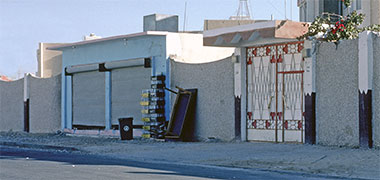

This model continued for decades and would continue to do so until the Government attempted to get some form of control over it by requiring shops to be grouped in local centres rather than being distributed within residential areas. In this there is a certain amount of conflict with traditional socio-cultural moraes, though this might be debatable. More has been written about the thinking behind this issue in the pages dealing with an approach to residential layout and elsewhere. In essence the issue revolves around privacy, safety and security – more perceived than actual – within residential areas. In the first of these two photographs, taken in the Intermediate Staff Housing Project in the New District of Doha, 1985, an owner has created a double garage with the obvious intention of using them as a retail outlet. In the second photograph, an older grouping of shops let into the boundary wall of a house in a residential area of Doha attract custom at night.
The commercial model mostly used by merchants was to stockpile material and sell as and when it was most profitable. This often resulted in perishable goods being sold significantly past their best. Doha and Wakra were the main ports for the introduction of goods though Dukhan and Umm Said also saw material introduced in the fifties, the latter having access to deep water, Dukhan’s access being more problematic but nearer the source of future wealth.
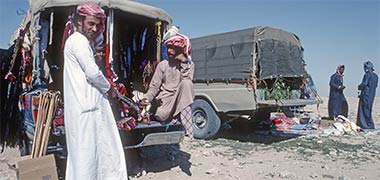
The villages didn’t develop specific locations for uses such as barbers, butchers, tailors, laundries for some time, most of these activities taking place in Doha or within an existing home. I can recall in the seventies badu coming to have their hair cut and to buy sandals, tooth cleaning sticks, perfume and the like. That is not to say that there wasn’t a market elsewhere. Here a group of badu merchants are seen selling the necessities of their travelling life at a razeef in the desert.
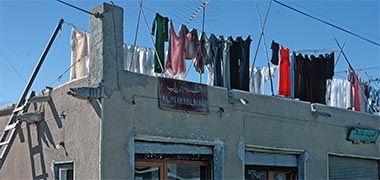
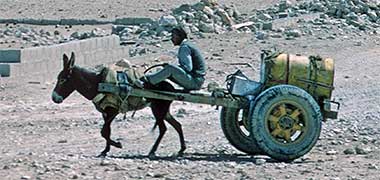
Laundries were one of the features of the areas outside the centre and were usually organised so that the roofs could be used to dry the clothes. Often the laundries were associated with a tailoring facility. Washing took place in the courtyard where the clothes were beaten in the traditional manner and the water – stored in the ubiquitous rusting galvanised iron tanks – used sparingly of necessity. Laundries were dependent upon the provision of water which only became a practical proposition around the middle of the nineteen-sixties when the desalination plant at Ras Abu Aboud effectively came on stream. Prior to that, and into the nineteen-seventies, water was still moved around the peninsula to people who were not yet connected to the water system as witnessed in the lower photograph, taken in March 1972.
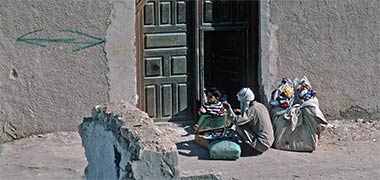

Qatar is no longer the country it was in the seventies and habits have changed. But somewhere I must have mentioned that it was Qatari men who did the shopping, and that it was rare to see women in the suq, particularly from the better families. Because of this a number of salesmen, mainly from the Indian sub-continent, could be seen daily travelling round the residential areas bent double with extremely large bundles over their shoulders containing the range of items that appeared to be needed for the running of homes by the women confined there. These they would patiently lay out at the doors of a house and then bargain with the person responsible for running the household, usually the most senior wife. Children would take the opportunity for these breaks in the routine of the day to participate or at least witness, as can be seen in these two images.
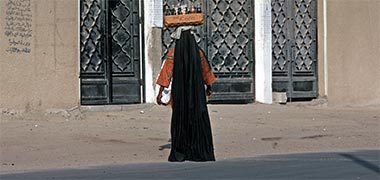
But it was not only men who travelled the towns, selling goods door-to-door. On occasion women were seen moving between houses with items for sale. In this photograph, a woman is carrying a number of bottles of soft drink and packets of Zabada cheese on her head while speaking with the gatekeeper squatting against a column to the entrance gates in feriq Rumaillah. It is probable that she was a Baluchi. There can not have been much profit in what she had to sell, and many houses would have bought soft drinks in bulk even in December 1973 when the photograph was taken. This illustrates something of the poverty in the State at that time.
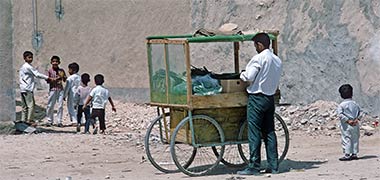
In addition to the travelling salesmen providing daily necessities to the suburban residential households, there were others taking the retail experience to those who were unable to go to the main suq, generally women and children. This photograph shows a mobile operation selling, as far as I recall, a form of bread, pastries and sweets. Some of the carts partially enclosed with glass screens to keep the flies off, others relied on netting.


Returning to the suq barber shops were a feature that most probably would have arrived only when there was a need created by the burgeoning expatriate community as the barber’s shop was a feature of urban communities in the Indian sub-continent. Qatari men would have had their hair cut by other members of the family until there would have been a reason to have it cut more professionally. Thinking back, I don’t recall seeing Qatari men having their hair cut in the suq, only expatriates. Oddly, I can remember badu being shaved in the suq, but it is unlikely they would have had their hair cut as, traditionally, they kept their hair long and oiled. However, the majority of people having their hair cut and being shaved, were expatriates from the Indian sub-continent, Thursdays being a popular day to be coiffed in order to prepare for Fridays when Pathans and Baluchis would come into town dressed in all their finery and, in the lower photograph, have their lives enlivened by viewing the latest pin-ups. These two photographs illustrate something of the change that took place in half a generation.
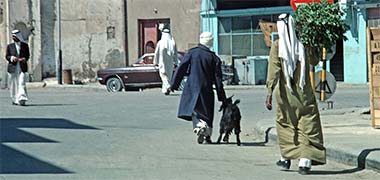
Originally, butchery would have been carried out by householders, a common sight in the suq being animals being led away. Butchery, in common with noxious uses in Islamic urbanisations, was confined to specific areas of the town; not only was this the case for uses associated with smell and noise, but other uses tended to be located adjacent to each other. In Doha this seems not to have been the case for butcheries which were located on the edge of Doha’s central suq, but were not grouped together. I’m not aware of the importance of halaal in Qatar, though it must have been seen as a normal function in the strict religious regime of the peninsula.
The shop was a place where the community met and talked over issues of the day, only in the late seventies the function of operating the shop being looked after by expatriates from the Indian sub-continent or Iran where the shopkeeper would double as servant, guard and driver. This is still seen to be a useful operation.
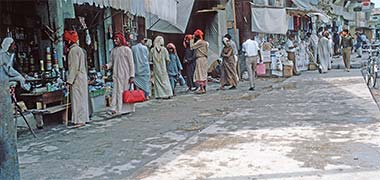
I’ve mentioned previously that Qatari men traditionally met and discussed events at a number of formal and informal activities, one of the most important being while shopping. My experience is that men would go to buy certain products every day and would sit with shopkeepers who were friends as well as take a tea at one of the many tea stalls. Here they would meet and discuss events as part of the informal majlis system. Until the nineteen-seventies, many of the store holders were Qataris, but this soon changed with expatriates from the Indian sub-continent taking their place.
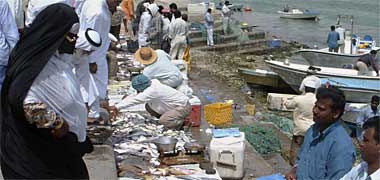
Fish, incidentally, are still bought at the quay-side though there are both a centralised fish market as well as areas to buy chilled or frozen fish in the many supermarkets in the country. In this photo an elderly Qatari woman bargains for fresh fish at the quay-side in Doha. Thirty years ago, at the fish market and quays, there would be young foreign children who both acted as porters for the fish purchases as well as gutting fish and shelling prawns extraordinarily quickly.
The reasons for the traditional pattern of shopping were three-fold:
- firstly, shopping was a utilitarian activity, providing the food and items required by the family,
- secondly, it was not a social or leisure activity to the extent it now is, there being no consumer and advertising pressures to speak of, and
- thirdly, for reasons mentioned previously, the women of the family were inhibited from meeting outside the house in order to preserve the good name of the family, shopping being chiefly a male pursuit.

Nowadays there is a massive retail operation within the country, commonly thought to be greater than the country can sustain. I don’t want to go into the economic side of this here, but the outcome of the construction of so much retail space means that there is significant choice, though this does not necessarily mean that goods are relatively inexpensive as might be anticipated. Shopping is popular for a number of reasons, but its importance as a social activity should not be underestimated. This is discussed a little further on the urban design pages and elsewhere. Here a family and female friends meet in one of Doha’s many malls. Note the handbags and puchase bags as well as the styling of the edge of the nearest abaya.
The classic hierarchy of retail spaces still exist and are easily recognisable. The lowest element of the old system has long since gone – the itinerant merchant carrying his or her wares round literally from door to door – stopped in the 1970s with the competition of the local stores. The women, dalalat, would walk from door to door, their wares wrapped in a large bedsheet, mostly selling clothes and household necessities to the women of the household. But men also carried out this function and, additionally, kandiri travelled around with donkey-drawn carts carrying water or kerosene to sell to the household.
I should also mention that there was a very active market in junk and scrap in the country. Known as the suq al Halaj, or ‘second hand suq’ to expatriates, it originally was situated at the edge of Doha’s suq and sold everything that might be of use, and much that might not. Today we would consider it as being a recycling centre as it was obvious that many of the items had a second life. That suq moved to the south of Doha when the centre of Doha was redeveloped, and grew dramatically in size, the metalwork industry being situated along with it, sensibly, as much of the items there were used by it.
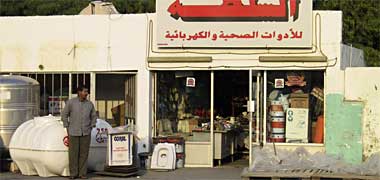
But the first element of the retail hierarchy, the local shop, still exists all over the country. Commonly it is found, as here, in residential areas where it is often created by the development of a garage from which items are sold that have been brought in by the houseowner either as an element or an adjunct of his business. An employee, perhaps somebody who is also gatekeeper or watchman will look after it for him, and it will be open all day from early in the morning until late at night. In the evenings it will not be uncommon for the owner to be around when he will meet friends and see to any business that’s necessary. It may not have a great return, but it will be providing a service for the immediate community both economically and socially.
One of the chief characteristics of this scale of shopping is the way in which it integrates with activities in and around the house – particularly the majlis – together with the local masjid. This is true at mid-day but particularly so at night when there seems to be a seamless movement in and around the area with individuals coming and going. This seems to me to be the epitome of the formal and informal majlis system working at its best, joining the whole of the family with the neighbourhood.

Although there are local shops within easy reach of every community, there is one item that is needed for all meals but which is not manufactured locally. khubz is used with every meal, or at least presented if not eaten. Traditionally, khubz is made with unleavened flour by placing a flat circle of dough firmly against a hot, clay wall which cooks the khubz in a few seconds, producing a disk with a large air space in its centre. The bread is eaten by tearing it and using it to grip food as well as to wipe up gravy both from dishes as well as fingers. But due to the hollow in its centre it can also be used to produce pockets for suitable foods and is popular for that function as well. It is a very useful commodity. The khubz produced by bread shops varies from one to another, some customers travelling a considerable distance to obtain their favourite khubz. They are particularly busy around meal times when people drop by to pick up what they need, preferably hot from the oven. But there is also considerable waste; it is common to see it discarded round town, an issue that has taxed the municipalities for some time.
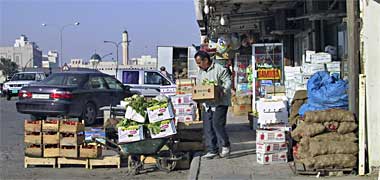
The next stage in the hierarchy are the retail units that form a local centre. Often this will be along a secondary road and will include a range of units ranging from juice stalls and cafés to stores and retail units selling a wide range of items ranging from those needed for major and minor construction to edible goods and entertainment. Some stores at this scale are run by their Qatari owners and, again, act as majaalis through the day in a similar manner to the small units which tend to have their owners around at lunch time and evening after prayers. I have no reason to state this as a fact, but I have the feeling that these centres are not as well visited by women as either local or district centres.
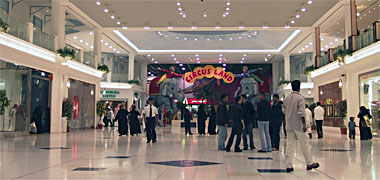
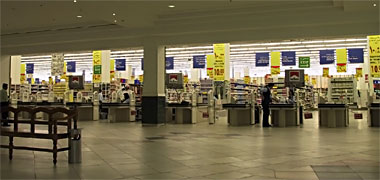
While local centres cater for everyday needs, district centres commonly have a wider range of goods for sale. The pattern in Qatar has been, over the last few years, for those with sufficient funds to develop major centres in different districts of the city, usually known by the named after them. They are air-conditioned, spacious, finished in expensive materials and contain a wide range of retail outlets populated by good-looking sales staff selling, in the main, well-known up-market products. While the centres seem busy, particularly at night, my experience is that there is not a great deal of purchasing taking place. The other important function they have, that of the majlis, appears to relate more to the young than the older Qatari as the meeting areas – places that people can sit down naturally and converse – tend to be well-known fast food outlets and coffee shops which favour the young.
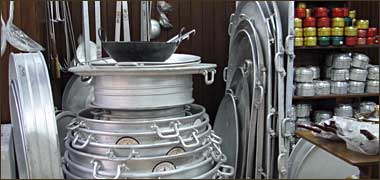
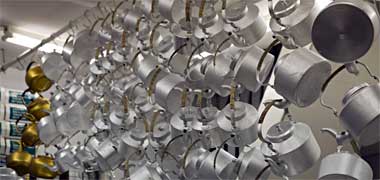
In the past the suq was the place people went to buy their household goods. This first photograph shows the kind of pots and trays that are so necesssary to Qatari cuisine but which are not generally found in the West. Both pots and trays need to be large in order to be used in the cooking and presentation of whole animals, usually sheep. The other item that is a necessity in all kitchens as well as in the desert is the kettle. They seem to come in one of two finishes, either enamelled or aluminium, as shown in the lower photo.
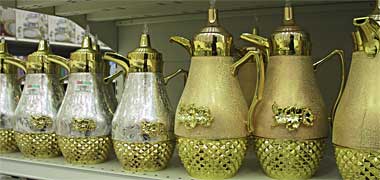

As larger shops opened along the main artery out of the suq, the wadi sail and roads joining it, they were able to bring to market a larger variety of items, widening the choice for consumers. Items such as the necessary insulated della appeared in a range of sizes and qualities to suit the market. Now this choice has moved to the new centres where there is an even wider selection. Much of the older della came from China. I don’t know where these particular ones come from but suspect the same source.
As I have written about elsewhere, these centres tend to be part of a recreational and retail experience that is now a part of life not just in Qatar but elsewhere in the world. They are places where families can meet informally, young people watch each other in relative safety, and the foreign workforce experience some form of relief from their daily occupations. The way in which this benefits the retailer will be dealt with elsewhere.
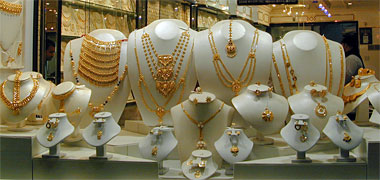
I should have mentioned that the old suq in Doha was divided into areas each selling specific goods. This system for the location of retail and manufacturing operations has been in use, not just in Qatar, but all over the Arab world and elsewhere for centuries. In fact, traditionally there were many laws relating to their specific and relative locations which can be seen in the layout of many of the older Arab towns. The practices relating to noise, smell, transport, disposition of refuse and the like were gradually defined, refined and incorporated into civic ordonances in order to benefit both those operating those facilities as well as the general public.
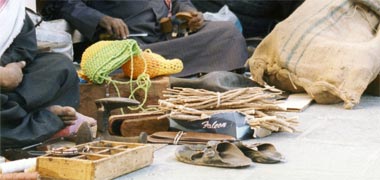
In contrast, outside the main masjid were those items relating to the activities in the masjid where you could buy a quran or misbah, have your feet shod and sandals mended, buy miswaak, teeth cleaners, and have documents read to you or written for you by a kaatib who sat outside under an umbrella, a typewriter on a low platform. This photograph, taken in 1985, shows a typical corner of the street including simple baskets woven by fishermen from fluorescent plastic cord.

Adjacent to this, in a more modern construction, was the tailoring suq where Qataris would go to have a thub or bisht made for them. Tailors also made dresses for women and this practice continues with male tailors sewing and fitting dresses, the latter measuring by eye rather than touching their clients. The shops in this area also sold some of the accoutrements for hawking. Part of this area was also used for the manufacture of cotton-filled mattresses, the production of which created a mist of cotton dust which wafted down the alleyway.
Opposite this part of the suq was the main part of the suq that sold more mass produced clothing and general purpose goods including light tools, chains, ropes and the like. Through them were the heavier materials, picks, shovels and boxes for travelling and, through them and nearer the sea, spices and materials and equipment for cooking.

Also in this part of the suq was the gold suq, the windows displaying gold to attract Qatari women who would buy the precious metal both as ornament and security. This photograph shows the kind of arrangement which many shops in the gold suq have in their windows as gold bangles are one of the most common purchases by women. Seen in bulk, bangles tend to look cheap; compare this photo with that above. These bangles are relatively simple in design with either twisted or engraved decoration. They don’t have the bulk of the silver bracelets common among the badu in Saudi and Qatar, presumably a reflection of the value of the two metals. There is a little more written about them on the next page.

Gold is sold by purity, weight and the amount of decoration, the gold never being below 18 carat purity. There is no assay system, but it would be a commercial disaster were a merchant to be found to have adulterated his gold. This solid gold necklace is of a type rarely seen in the West but are popular in the region. As I have written about elsewhere, women believe it is important to have something to fall back on in the event that they are divorced and it is imperative that they obtain value for money. I have been told that it is traditional to wear bracelets in multiples of five, representing the five tenets of Islam, but I also been informed more recently that, traditionally, women wear bangles in pairs, that is two or four or six on each wrist, the number depending upon social status and the prevailing fashion, but not usually exceeding a dozen on each wrist.
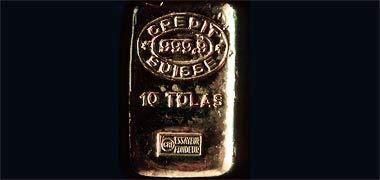
Gold is also sold as bullion and many Qataris like to be able to own this valuable resource in the form of a discrete bar which has not only considerable value but a pleasing tactile quality. This photograph is of a ten tola bar which, as you can see from the photograph, is stamped as having 999.9% purity. At 3.75 troy ounces, these small bars are extremely valuable and a useful way to keep as a hedge against inflation, though traditionally they were considered to be an insurance against divorce, unforeseen events and disasters.

Also in this area were shops selling perfumes in the traditional manner. This has been a long tradition in the Arab world with specialists mixing the oils to order. Rows of bottles containing oils were used to mix and fill small glass or corked aluminium containers for customers. This area had a distinctive smell as did all areas of the suq. I should also mention that it used to be possible to buy copies of popular commercial perfumes. I don’t know if this is still the case.
Returning to planning theory, at the top of the hierarchy is, usually, the city centre. Doha has a city centre but the development of the West Bay with its concomitant retail centres, together with a large number of competing district centres, have starved it of the opportunity for major retail centres of its own, the type that would be found in the centre of any Western city. To some extent this is a function of ownership patterns, but it was possible to deal with this elsewhere and should have been in the centre.
But as I wrote about on the Islamic urban design page, Doha’s centre has been completely redeveloped. A major road, Grand Hamad Avenue, was driven by the planners through the middle of the suq leaving some of the old two-storey shops to be redeveloped in an architectural form thought to be accurate of its past. I understand this to be a deliberate policy reflecting a need to encourage tourism. It is interesting to note that already Western visitors to the city are photographing it and believing it to be authentic…
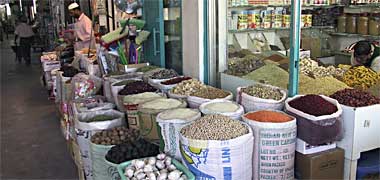

Inside the new development many of the old retail uses – tailoring, clothes and shoes, dress materials, hunting goods, spices and tools, together with scribes, shoe cleaners and so on – remain but the suq is a shadow of its former self. In the daytime it appears to be relatively empty compared with its former self, though Qataris do visit and traders continue to sell to them and others. There are now many aswaaq located around town, and competing with it. Its great advantage is that it is central and continues to sell a wide range of a small group of goods such as spices and kitchenware, inexpensive tools and clothes.
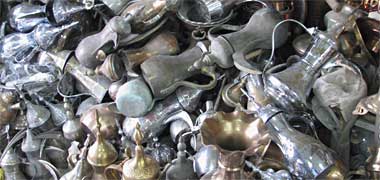
Old goods are also sold. The lowest photograph is of a pile of dellat that have had their day. Once the tinning on the inside goes they either have to be thrown away or re-tinned. These can be seen to have come from a number of sources, and are not all of the traditional brass sort.
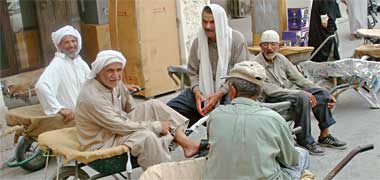
One of the features there has always been is the need to have porters to move heavy or awkward loads for those buying in the suq. Here a group of men sit on their modern wheelbarrows, lined with sacking to protect the goods carried. Before metal wheelbarrows took over the role, the barrows were constructed as flat wooden platforms and the porters used ropes slung over their shoulders to manage the heavier loads. A generation ago these porters would be seen carrying loads to the residential areas surrounding the suq. Nowadays it is more likely they carry only to the car parks surrounding the area.
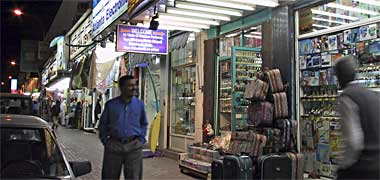
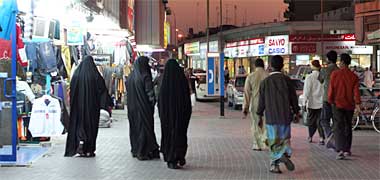
But the centre of gravity of the commercial operations has moved south and west along the wadi sail to the larger shopping facilities that have managed to sustain their competitive edge due to a combination of their size and the fact that their development costs were amortised a long time ago. Many of these shops still have Qataris in them but in the main the area is heavily given over to expatriates both running and using the shops.
One of the reasons for this is the large number of expatriates living nearby in the old inner housing areas. In these two photographs you can see a little of the character of the area at night with expatriates moving around, and including a small group of women. It is a functional area with reasonable prices, lively at night and catering for those who do not large amounts of disposable income.

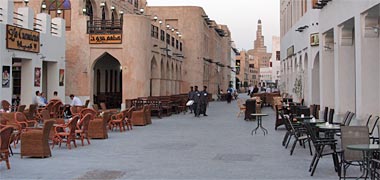
Not far from this is the newly redeveloped suq whose concept and architecture I have commented upon in a number of different parts of these notes. This is still a functional area of the centre but has been designed to demonstrate to visitors a vision of what the centre might once have been. It is a part of the modern, international trend to produce settings in which people can enjoy themselves, albeit in a different manner from its original construction as a functional suq – a place to purchase the requirements for life in Doha. It reflects the transient society of expatriates rather than established Qatari society. It is to be visited as an experience rather than a requirement of daily life. You can see a hint of this in the upper photo which has a large wooden camel for sale bottom left and, particularly, in the lower photo which looks as if it has been designed with Western café culture in mind.
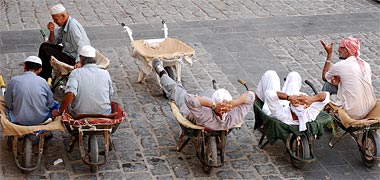
Nevertheless the centre still serves as a place for nationals and expatriates to shop, and there continues to be the need for large items to be moved from the dukaakeen to the car park that is situated on the old maqbara at the south-west side of the suq. Because of this there appears to be a continuing need for porters to carry heavy goods and they now operate in and around the suq with wheelbarrows as their mode of transportation. Here a number of porters rest, waiting for customers to collect them and take them to the dukaan from which they need their goods removing.

It was quite common to see goods being moved around the suq by porters pulling large loads on two-wheeled barrows, but loads were also carried in some of the taxis which stood in the centre of the suq. Larger loads, as well as livestock, were transported on pickups, as shown here on the Rayyan Road with sheep and a labourer in the back of a pickup, or on lorries.
As mentioned above, part of the move to create attractions to the peninsula has seen the centre of Doha completely rebuilt. The development of suq waqf will be looked at on the Gulf Architecture pages from a design point of view, but here I would like to mention the development of the suq in its socio-cultural and economic sense. These two photographs illustrate one of the aspects of the new suq. With the construction designed to appear authentic, similar pains have been taken to install in it other elements that are, or appear to be, traditional and are intended to encourage visitors and the revenue they bring.
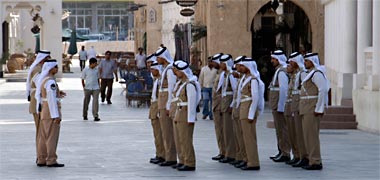
This first photograph shows a squad of police drilling in the centre of the suq, wearing the uniform that could still be seen in the suq in the nineteen seventies, where a policeman stood on a small raised platform directing traffic near to the Central Police Station. Generally the police wore, and still wear, dark blue uniforms, but this traditional dress appears to be directed at the tourist and visitors’ market. As such it might be thought that the wearers of these uniforms are somehow diminished by their appearing to be actors on a staged set; they certainly are photographed by visitors, and this has to be a response to the way they dress. Yet they are real police officers carrying out the normal work of the police in the suq.

This photograph illustrates a relatively recent introduction to suq waqf. Two mounted policemen in traditional dress patrol through the suq wearing bandoliers, and with highly decorative tack on their Arab horses. Again, this must be for the benefit of the visitors and tourists as there is little additional function to be gained by being mounted, a form of policing usually associated with ceremony or crowd control. However, it is a pleasant and attractive introduction to the business of the suq. As an aside, I should mention that, a generation or so ago, the suq was policed at night by private, armed watchmen paid by the merchants, even with the central police station being situated at the north end of the suq.
![Three uniformed soldiers – with permission from Qatar&Me [SAVE GAZA] on Flickr Three uniformed soldiers](./islamimages/threejundi.jpg)
This third photograph, however, introduces a different effect. The uniforms above are traditional and are understood to be traditional by those visiting the suq. This, however, is slightly different as the uniform worn here by what I believe are three soldiers, is obviously different, the material of the tunics being unusually highly decorated, as appear to be the ghutrah. In many respects, these uniforms seem to fall into a similar category as do the uniforms of the musicians shown further up the page. Both represent a view of reality that is at odds with tradition and move those wearing the uniforms into a different socio-cultural area, one that is more definitely a part of the entertainment industry. This may be thought reasonable with respect to groups such as musicians and dancers, but when it comes to the police and army, it may appear that they have been subordinated to an acting role, when this is clearly not the case: they carry out real work with considerable responsibility. It is true that military groups all over the world have dress uniforms as well as battledress, and that the uniforms here may have a traditional basis, but they still appear within an entertainment context and have a theatrical aspect to them.
The purpose of using these illustrations is to show how institutions are being used to respond to touristic development, as it is termed. As such they are weakening the links they have to the traditional way of life of the peninsula. This in turn loosens the traditional socio-cultural fabric of Qatar.

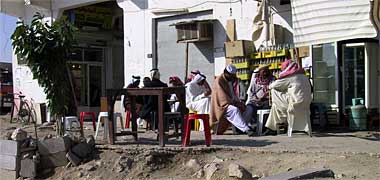
Some of the retail units in the old suq are still run by their Qatari owners. This is particularly true for the tailoring and hunting units and these, together with the tea shops still remaining there, draw many of the older Qataris to meet their friends and remind themselves of the old days. I should also add that the old suq, as well as some of the more local shops, are popular with Qataris as they like to obtain fresh food every day. It is not just bread, but vegetables, meat and fish are bought fresh where possible.
![Young Qataris sitting at Western style coffee shop with permission from Qatary Unique ! [BUSY!] on Flickr Young Qataris sitting at Western style coffee shop from Qatary Unique ! [BUSY!] on Flickr](./islamimages/starqats.jpg)
So, the importance of shopping for Qatari men and women continues with modern developments, but in a different way. The old suq is no longer the draw to men that it was, though it brings some men and women to it in search of fresh spices and the like, but it does seem to represent a dying focus for Qataris. The majlis system continues there for a few men but, in the main it is the district and local centres where the informal majaalis operate, particularly at the local level. Above you see some young Qatari men meeting at a Western style coffee shop in one of the major commercial centres.


Nevertheless, young and old still meet in the majaalis of their peers as well as in the more formal majaalis of others. There, Arabic coffee, tea and soft drinks are still drunk. These two photographs show a simply decorated Arabic coffee cup, or finjaan, the top photo showing a small quantity of the cardamon seeds which are added to the coffee to give the characteristic flavour to this traditional drink.
In the second photo, and shown held in the right hand, is a finjaan from which the qahwa is sipped hot. Elsewhere I have mentioned that it is polite to have no more than three cups of coffee and, to show that no more is required from the person pouring it for the guest, the cup is shaken slightly as it is handed back to person holding the della.
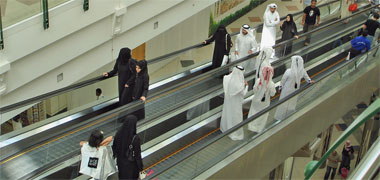
Women are chauffered more than they used to be and continue to buy as they did in the main suq while also visiting the local and district aswaaq where fresh material is brought in. They also are keen visitors to the larger, modern centres both with girlfriends as well as with their husbands and children. This is very different from the habits of the last generation. Although, as I have suggested, young men meet in these centres in an informal approximation of the majlis, it is also notable that women, in also going to the modern centres in groups, can be understood to enjoy a similar system outside their houses and the privacy they enjoy there.
It is arguable that the absence of tea shops in these new centres, the lack of Qatari owners sitting in their shops, the different shopping and spending habits, the times of schooling and the diminished amount of time available from a higher work regime have dramatically influenced the pattern not only of shopping, but of social engagement.

By that I am really referring to social engagement within the household. But, from the preceding paragraph, you will understand that the opportunity for social engagement both in an active and passive sense can be found in the public arenas to which men and women – particularly the latter – now have access. This group of young women ordering a meal at one of the many new fast food retail outlets can do so as they act as their own chaperones, and there is now a general social acceptability for their having no men from their families with them. This flies in the face of traditional religious practice in Qatar and its hinterland but gives an added piquancy to the women in their opportunities for education and the novel requirements for programming their lives throughout the day. This freedom is not yet fully accepted as many families continue to constrain their women’s activities, but it obviously represents a trend in the region which is being looked at by many interested parties.
Impact on design
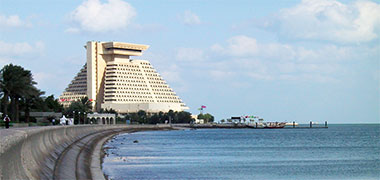
Increasingly there is a drive to bring tourists to Qatar. Other Gulf States, notably Dubai, have had considerable success in catering for the more affluent tourists, and Qatar is also involved in this market area. Hotel accommodation is generally first rate with rooms that are generally larger and better appointed than might be found elsewhere, in large part due to their being constructed relatively recently. Food and service matches the design and general standards of these new hotels with many of them attempting to enhance revenues from pool or beach side activities and the serving of food and drink.

It is believed that tourists find the beaches and shopping malls to be a strong reason to spend a relaxing visit to the region and, with only a small variety of attractions outside the urban centres other than a limited exposure to the desert in four-wheeled vehicles and camel rides complemented by ‘traditional’ meals, it is the hotels and malls that predominately reflect the country.
Having said that, Qatar is building a series of cultural collections of local, Arabic and Islamic importance in the area of the old port and feriq al-Salata. It is anticipated that this will attract greater numbers of visitors to Qatar through the quality of exhibits in the Museum of Islamic Art, the National Museum of Qatar and the projected Art Mill.
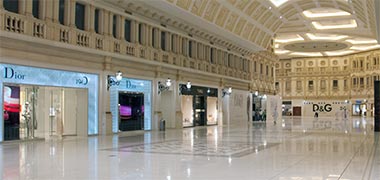

The retail opportunities are increasingly similar to those found elsewhere in the world, the main shops being positioned in large malls and being outposts of the well-known brands found in the West. Because of this, and particularly because of the need for those concerns to advertise through their brand logos, malls tend to appear little different from Western malls except for the presence of a multi-national range of shoppers or, more often, sightseers. In this they reflect the transient characteristics noted by Rem Koolhaas. In the photographs here you can also see something of the trend to introduce a classical architectural vocabulary in order to create an international and up-market ambiance to the shopping experience, in this case on a very generous scale.
For tourists there is a dichotomy: two of the main attractions to the region are the weather and the controlled climates of building interiors; but there is also a significant lack of diversity, particularly cultural diversity – the lack of a connection with the traditions and history of the region. This disconnect does not allow a genuine association with the cultural and historical past, other than in the way in which these are presented world-wide – with the collection of artefacts and buildings by the State, and in the design and construction by the private sector.
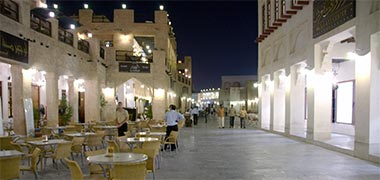
In Qatar there has been a serious attempt made to provide attractions for tourists in the suq waqf. The suq is very popular with visitors and gives something of the feeling of the old suq to those moving through it. Some even believe it to be original. This photograph, taken in 2008, shows how the introduction of paving between the reconstructed traditional buildings, together with a café extending into the old street, attempts to bridge the gap between past and present, providing a safe area for nationals and non-nationals to walk and sit.
While the old suq sold much of the items necessary for living, the new suq does not, as those items are, generally, bought elsewhere. It is true that some of the goods sold there, such as gold, perfume, traditional clothing, might attract local consumers, much does not. Instead, the market is focussed more on items likely to be bought as souvenirs by tourists.
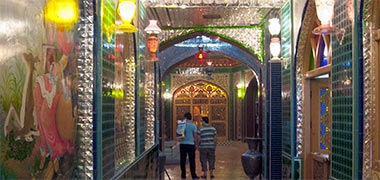
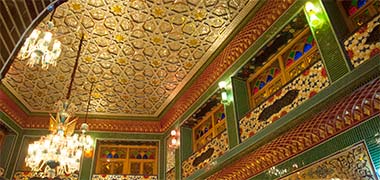
To buttress this shopping experience there are the restaurants and cafés that cater for a wide range of international tastes and, as such, are not traditional to the peninsula. The food is good, reflecting the pressures on the expatriates brought in to run these outlets, and there is intense competition across a wide range of pricing. This has been reflected in interior designs that are created to connect the character of the food with its corresponding ambiance. As in much of the world, this creates a pastiche, though it is obviously understood by visitors to be that. These two illustrations show something of a design effort to incorporate elements of the local geometry of traditional design with cultural aspirations introduced from elsewhere.
Although there is an identifiable cuisine in Qatar, regrettably it is not one that has witnessed a commercial outlet other than in the desert events provided for expatriates in the desert. Cooking traditional meals at home is now heavily supplemented by ready-made meals picked up on the way home or delivered due, in great part, to the fact that work habits and educational requirements mean that individuals within families now have to work to differing schedules, making a family meal difficult or impossible to organise.
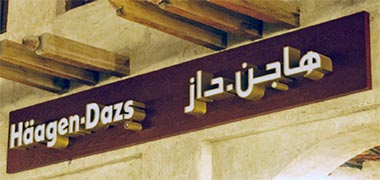
Within the malls the main design elements are the branded retail outlets, and it is in this area that Gulf Arabs are being heavily influenced by external advertising. Here is one example, though this sign is not in one of the malls but in suq waqf where it sits under the reconstruction of a traditional projection of shandal timbers. Branding is now very important and, with the large disposable incomes available, influences shopping habits and retail behaviour. But it can create problems. A little more has been written on transliteration of Western names on another page of these notes but, in this case, the hard ‘g’ sound in the first word is translated into Arabic with a ‘jeem’ which, in Qatari Arabic, is pronounced as a soft ‘j’, diminishing the local language.
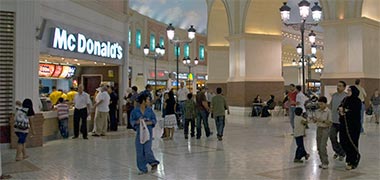
This type of advertising is insidious and affects young Qataris to a large extent. There is little or nothing left of their built heritage, and this is compounded not only by selective reinterpretations of their cultural past, but also by the overwhelming expatriate population and their cultural baggage driving much of the information nationals receive visually, aurally and orally. Within the tertiary educational system there are heavy foreign influences which impact perceptions and standards. As mentioned elsewhere, there is some resistance to this, but it is there nevertheless.
Branding, as mentioned above, is now one of the most important characteristics for the younger generations throughout the Gulf. It is notable that Qataris will tell you the precise brands that are important to be seen wearing, all of them Western, though there are the occasional Arabic dressmakers whose work is well regarded. But shoes, jewellery, watches and handbags must be from important designers. Perversely, at the same time it is possible for women to be wearing jeans and t-shirts below their traditional covering.
While some of the work of the international designers reflect, accidentally or not, traditional design motifs from the region, high disposable incomes drive the ability to purchase clothes and jewellery and the concomitant design influence increasingly experienced both outside and inside the home. It is both inescapable and highly intrusive, just as it is in the West.
There is further evidence of the trends to an international design view of the world. Houses a generation ago might have incorporated a specific ‘Arabic’ room, this would have been related in design terms more to the northern Arabic regions. Now the rooms being incorporated into houses have more to do with novel functions – spas, games rooms, cinemas, gyms and the like – but will have been designed in an international style rather than in a traditional Qatari or an ‘Arabic’ style. Predominately there will be a foreign flavour to it if for no other reason than that the activities within them are not traditionally found in the peninsula.
The ‘Arabic’ room seems to be slipping or has slipped out of fashion, though the majlis remains a necessary functional space for men and tends to have a traditional feel to it if, in the most part, because of its layout. To some extent this is also true for women, but increasingly they are meeting in spaces relating to health and beauty within their homes, and in these spaces the opportunities for setting equipment within an ‘Arabic’ setting are limited. The interior designers who now are fashionably employed, must ensure that they cater for the demands of clients who are taking advantage of the widening scope of international design experiences.
more to be written…
Cuisine
In the past, Qatari women used to bear an unusually high proportion of the workload as they had to provide food for the family in times when there was often little that was palatable. Dates, bread and fish were the basic diet and this had to be sourced, bought and prepared by the women. There could be little variation and, in times of hardship, even date stones were crushed for food.
Water sources had to be filtered either through the use of a water jug or, more immediately, by drinking water directly through a ghutrah, a man’s traditional headscarf. Washing was carried out at the sea shore, usually by groups of women.
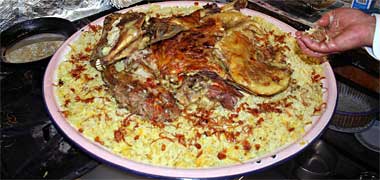

But times have changed. The towns are much larger, every Qatari family has a house together with the equipment needed to prepare a range of meals for families and their guests. But, despite this, some labour-intensive traditional meals are still prepared and enjoyed. The upper of these two photos shows a tray of machboos, in this case, meat on a layer of rice. Actually machboos refers to the method of cooking rather than the meal itself. I have written a little more on this on the Gulf architecture page. The lower photograph is of a typical spread set out when breaking the fast at ’eid, and illustrates a range of dishes giving a wide choice of food for the guests at this important meal. Note that some of the dishes appear to have been produced in the house kitchen and some bought in, an increasing option I have discussed elsewhere.
Cuisine has changed a great deal, this being the result of half a dozen factors such as:
- increased disposable income,
- the availability of relatively inexpensive help in the home,
- an extremely wide range of food products,
- a large variety of convenience food outlets,
- changing inter-personal family patterns caused by work and education opportunities, and
- travel.
I have made notes on these issues elsewhere but, in essence, it is very little different from what has happened elsewhere in the Western world where an increasingly prosperous society has travelled and experienced more, a wide variety of commercial opportunities have been exploited to increase the range and quality of food and related products available to the consumer, and where work opportunities or requirements have been available to an increasingly well educated society whose working hours are different from those in operation only a generation ago.
Although traditional family patterns are still very important, decisions made by certain elements of government, such as education – as well as competing activities such as personal work and work for government – have made it more difficult for families to eat together in the way they used to. It is now not uncommon for a member of the household, usually the father, to bring back convenience outlet meals for the the family, and for different members of the family – usually the younger male students – to eat out with their friends either at those retail outlets or at the majaalis of friends.
Traditional meals have been buttressed by a wider selection of similar products such as fruit, fruit juices, milk, yoghurt, cheese, bread and the like, but staples such as mutton, chicken, fish and camel are still the basis of traditional meals.
Presentation still tends to be made on a sufra though dining tables are also used in equal measure. There appears to be a preference for very sweet puddings as well as extremely colourful ones for which there has been a long tradition brought in from the Indian sub-continent.
Some forms of presentation are very different from Western ones, but more effective. For instance, the idea of floating fruit in cold, iced, water after it has been washed continues the practice of eating fruit, helps widen the selection for children and makes the fruit literally more palatable.
This issue is important because it is now recognised that young Qataris are increasingly suffering from dietary problems which, combined with lack of exercise, affects a wide group of Qataris. It is my experience that it is not just young Qataris who have developed a national sweet tooth.
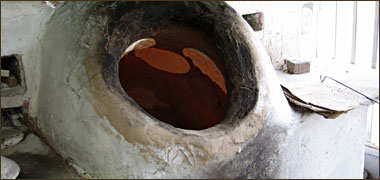
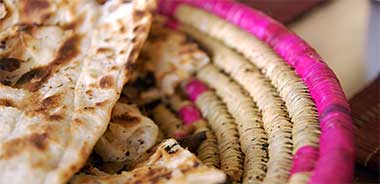
khubz remains the favourite complement to virtually any meal. Flat bread, as it is commonly termed by expatriates, is bought from nearby bakers by both expatriates and nationals alike, hot from the traditional ovens. It can act as a plate, a container, an implement and even something to wipe fingers on. Western style bread is rarely eaten though soft bread buns have been introduced to many households through their use as the covers for beefburgers and the like. The upper of these two photographs shows the traditional oven with three pieces of dough baking on its internal surface, placed there quickly with a deft slap to avoid being burned. The lower photograph illustrates a typical presentation of bread on a traditional woven flat basket.
This changed cuisine has been married to another issue I have written about elsewhere, that of the manner in which houses are laid out. Most professional Qataris will have a dining room in their house where their friends will eat if they don’t eat in the majlis. However, there is also likely to be a dining room in the family side of the house which is usually fitted out in a similar manner to a Western dining room with a central table, surrounding chairs, a sideboard or credenza and appropriate lighting and decoration. I have only eaten a few times in dining rooms such as these and I believe it is the exception rather than the rule.
More to be written…
Society 03 | top | Society 5
Search the Islamic design study pages
- Introduction
- Arabic / Islamic design
- Arabic / Islamic geometry 01
- Arabic / Islamic geometry 02
- Arabic / Islamic geometry 03
- Arabic / Islamic geometry 04
- Islamic architecture
- Islamic urban design 01
- Islamic urban design 02
- Islamic urban design 03
- Islamic urban design 04
- Islamic urban design 05
- Arabic / Islamic gardens
- Gulf architecture 01
- Gulf architecture 02
- Gulf architecture 03
- Gulf architecture 04
- Gulf architecture 05
- Gulf architecture 06
- Gulf architecture 07
- Gulf architecture 08
- Infrastructure development
- The building industry
- Environmental control
- Perception
- The household on its lot
- A new approach – conceptual
- A new approach – principles
- A new approach – details
- Al Salata al jadida
- Public housing
- Expatriate housing study
- Apartment housing
- Pressures for change
- The State’s administration
- Society 01
- Society 02
- Society 03
- Society 04
- Society 05
- Society 06
- History of the peninsula
- Geography
- Planning 01
- Planning 02
- Population
- Traditional boats
- Boat types
- Old Qatar 01
- Old Qatar 02
- Security
- Protection
- Design brief
- Design elements
- Building regulations
- Glossary
- Glossary addendum
- References
- References addendum
- Links to other sites